|
Duomo & Baptistry
Santa Maria Assunta |
|
this church now has its own page
|
|
The Madonna del Rosario
Via San Marco |
|
Maria Santissima
del Rosario
Via del Pignatello |
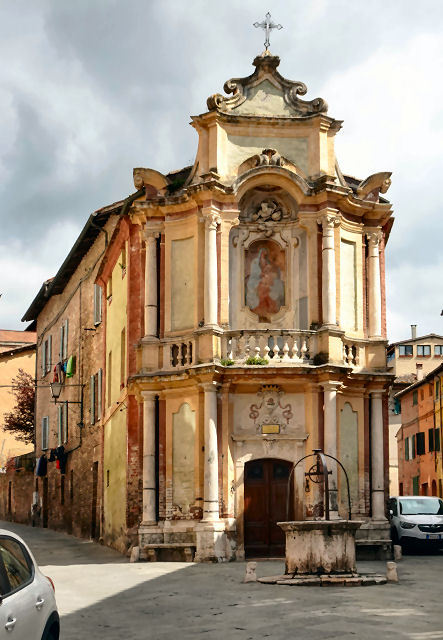
History
Built with locally-provided funds from around 1657, to designs by
Giacomo Franchini, (or by Pietro Augusto Montini in 1722/3) with stucco decoration by Pietro d'Austo Montini.
Deconsecrated in 1813 the oratory became an armoury but is now used
by the chiociolla (snail) contrada as their horse house, where the horse chosen for the
palio is kept for the three days before the race. This had been the
contrada's oratory, until it moved to the oratory of Santi Pietro e Paulo,
along with the art and fittings from here, which included an icon of the
Virgin painted by Jacopo di Mino del Pellicciaio.
Façade
On the façade, a stucco God the Father with Angels is
set above a repainted fresco of the Virgin and Child painted in
1742 by Francesco Feliciati. Below this is a fresco of a snail.
The well in front of the church, the Pozzo di S. Marco (well of Saint Mark) dates
from 1522.
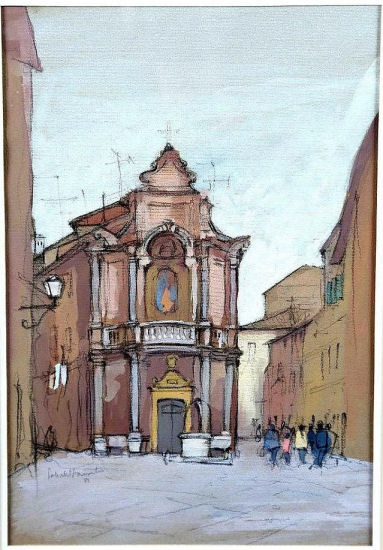
The church in art
Patrick Hamilton's watercolour of 1981 called
The Old Church (see right) is plainly this one.
Opening times Rarely
|
|
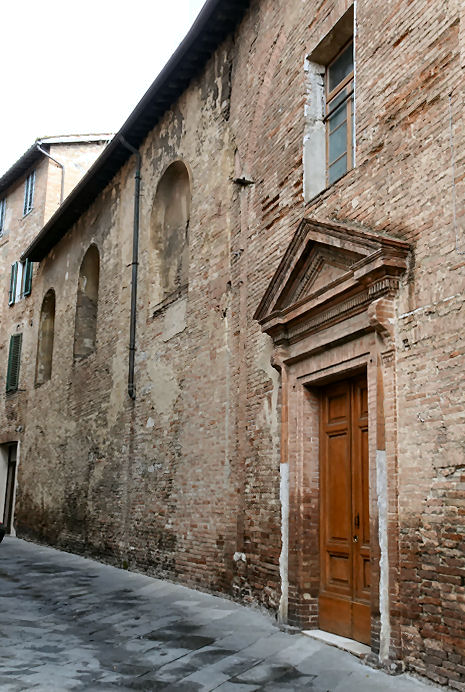
History
The church was built after the plague of 1348 to house the
Madonna di Monteguaitano, a small 14th-century wood and ivory triptych that was
an object of popular devotion throughout the century,
especially during the epidemic of 1348. So the church was initially called Santa Maria delle Grazie. The triptych
is now kept in the church of La Sapienza. (San Pellegrino alla Sapienza?)
In 1441 the church passed to the Convertites, who called it Santa
Maria Maddalena Penitente and who were here until the suppression of the
religious orders by Napoleon in 1809. It was under the
management of the Convertites that the church was much remodelled.
After the transfer of the church to the Diocese it was dedicated to Maria Santissima del Rosario of Pompei
.
Interior unvisited
The remains of 14th-century school-of-Lorenzetti frescoes in
the vault of The Evangelists and on the right wall of The
Martyrdom of St. Lawrence. The Virgin Presenting Christ to the
Magdalene in the dome is by Annibale Mazzuoli .
Opening times Rarely

|
|
Misericordia
Oratory -
Via del Porrione |
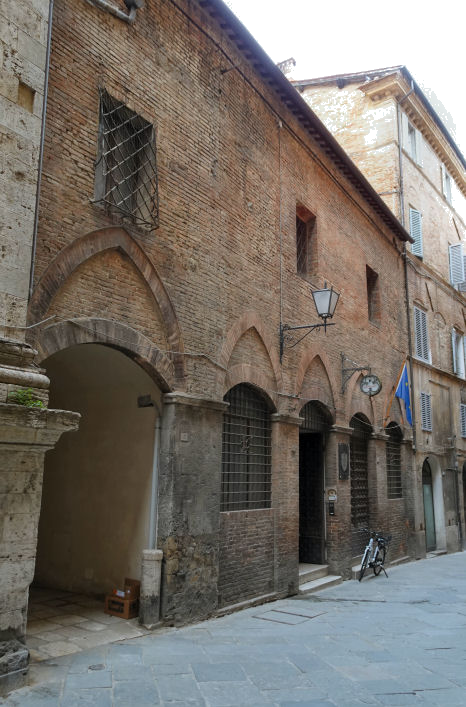
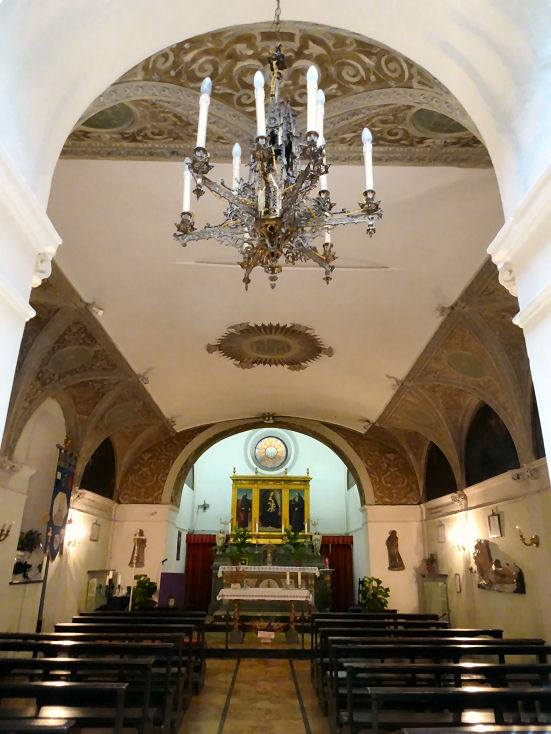
History
The current site was created between 1836 and 1838 by
combining the oratories of Sant'Antonio Abate, belonging to the confraternity
of the Misericordia, and the Madonna
della Stella. Today it remains the oratory of the Confraternita della
Misericordia di Siena, which was founded around 1250 by the Blessed Andrea Gallerani,
a nobleman and a soldier who had murdered a man in anger, considering him
to have blasphemed, and dedicated his life to charity and penance. He
became more than something of a local saint, despite not having been
officially canonised.
Interior
Entry is via an entrance narthex shared with the hospital where funeral
litters are displayed.
There's a small dome over the entrance hall at the rear of the oratory,
where to the left and right in niches there are The Annunciate Angel and
The Virgin, separate polychrome statues by the late 16th-century sculptor Domenico Cafaggi,
having previously been attributed to Marrina.
The oratory is very small, with a flat ceiling much decorated in a frieze below, with
seven lunettes. These show Stories of Saint Anthony Abbot executed in the
late 16th/early 17th centuries by a team consisting of Alessandro Casolani,
Francesco Vanni, Pietro Sorri, Rutilio Manetti, and Sebastiano Folli. But
it is too dark inside to see them well. There are two more lunettes in the shallow
rectangular apse.
Over the high altar is a triptych of The Virgin Child with Saints
Anthony Abbot and Paul, an early work by Girolamo del Pacchia (early 16th century).
On the first floor, in the Council Chamber of the Archconfraternity, there
are said to be coffin heads painted by Guidoccio Cozzarelli and Domenico
Beccafumi and a Portrait of Bartolomeo Carosi by Pietro Sorri.
Lost art
A panel of The Death of Saint Anthony from 1609 by Francesco Vanni,
commissioned by the Compagnia di Sant'Antonio for their oratory here, is
now in the chapel of Saint Anthony in the Cimiterio della Misericordia.
Opening times 7.00 - 7.00
I have now made the spectacular
Monumental Cemetery of the Misericordia
its own page, mostly of photos.
|
|
The Osservanza
San
Bernardino all'Osservanza
Strada dell'Osservanza |
History
Founded in 1423 by Saint Bernardino in
an attempt to return to the original Franciscan rule (or Observance) which he thought had
become corrupt. The land was given in 1404 by the hospital
of Santa Maria della Scala. The church was consecrated in 1451 by the
Archbishop Niccolò Piccolomini, with building work continuing from 1476-90, probably by
Francesco di Giorgio Martini and later Giacomo Cozzarelli. These buildings
where damaged during the Siege of Siena in 1554 and baroque rebuilding
resulted. After restoration between 1922 and 1932 the church suffered
serious damage from American bombs on 23rd January 1944, making it the
only church suffering such damage in Siena. Direct hits brought the
roof and vaulting down and destroyed the cupola 'almost entirely'. Rebuilding
followed, attempting to
return the church to how it looked in the late 15th century. The church
was rededicated and reopened in 1949
Interior
More than a touch of Brunelleschi, with three stout pillars each side,
separating the nave from the four side chapels each side with round
pietra serena arches. A large detached fresco and its sinopia
are just visible either side of the apse, behind the panelled and benched
choir with its dome. The fresco looks like an Enthroned Virgin.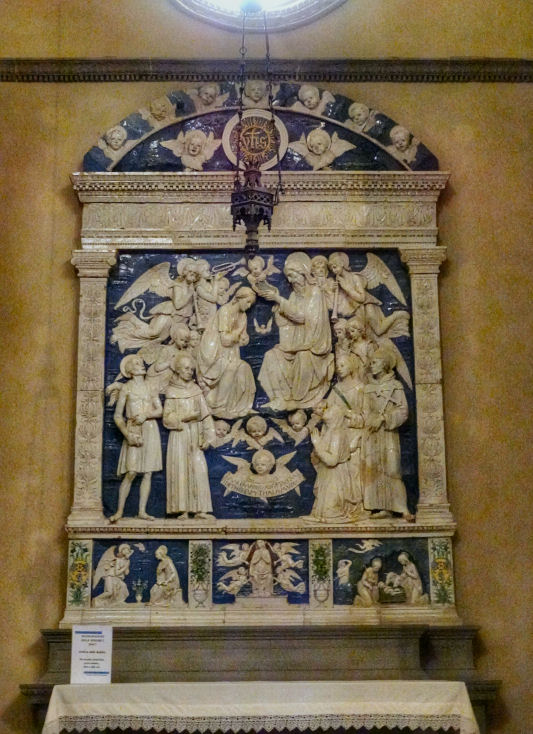
The church has works by Andrea della Robbia - an Annunciation pair
of statues either side of the choir arch and a Coronation of the Virgin
(see right) in the second chapel on the left, plus two tondi in the
counter-façade, depicting San Ludovico di Tolosa and
San
Bonaventura.
Also a triptych once ascribed to the Master of the Osservanza (and the
label attached still says so), but this anonymous master was in 2010 identified as the
young Sano di Pietro, thereby explaining our lack of knowledge of his
early career. He was originally called The Master of the
Osservanza Triptych after this very painting. It depicts the Virgin and Child with Saints
Ambrose and Jerome, is dated 1436, (fourth chapel on the right) and
was commissioned by merchant Manno di Orlando for his chapel in
San
Maurizio. Also by Sano di Pietro here is the Virgin and Child with
Saints Jerome and Bernardino painted a little later (third chapel on
the right) and a Virgin and Child with Angels panel (first chapel on
the left).
A polyptych by Andrea di Bartolo (part of a dismembered work) depicting
eight saints including, on the main register, Saints John the Baptist,
Francis of Assisi, Peter and John the Evangelist (1413) (fourth
chapel on the left).
In the first chapel on right is a detached damaged fresco of The
Crucifixion by Bartolommeo Neroni, called il Riccio, who also painted
the same subject, with saints, on a panel in the third chapel on the left.
In the crypt, with its
reverse orientation to the church, are tombs of the Petrucci family,
including the remains of Pandolfo.
Cloisters not visited
There are three cloisters, the largest dates back to the last quarter of
the 17th century, with an 18th-century well in the centre. The oldest is the southern cloister, currently
without its southern
wing, which is overlooked by the Pandolfo loggia.
The refectory not visited
In the refectory there is a large canvas by Francesco Franci
of The
Last Supper from 1710. On the altar of the sacristy there is a
late 15th/early 16th century polychrome terracotta sculptural group depicting
The Lamentation by Giacomo Cozzarelli .
Next door to the sacristy there is the museum dedicated to Aurelio Castelli, which
houses various works. These include the head of a processional Crucifix made by Lando di Pietro
in 1388 and
belonging to the Sienese Compagna di San Domenico. It came here when that
order was suppressed in 1785 and used to be over the high altar. Only
fragments remain following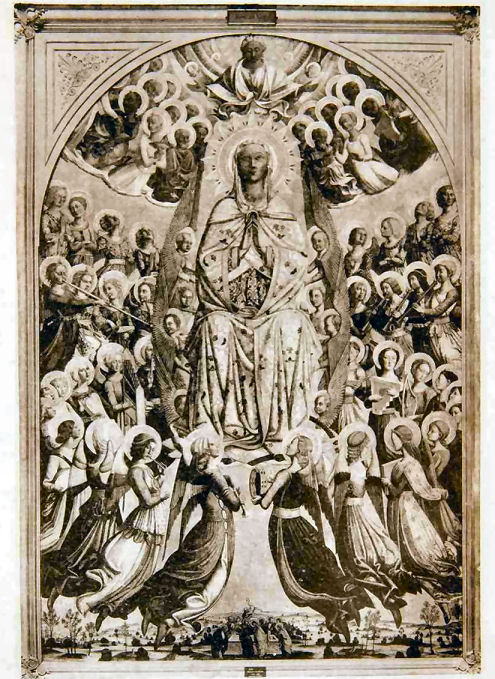 an allied bombardment in 1944. The destruction revealed a parchment strip
signed by the artist in 1338 asking us to worship the son of God, not the
wood, and the reliquary of Saint Bernardino of Siena (mid- 15th
century).
an allied bombardment in 1944. The destruction revealed a parchment strip
signed by the artist in 1338 asking us to worship the son of God, not the
wood, and the reliquary of Saint Bernardino of Siena (mid- 15th
century).
Lost art
A Saint Francis Receiving the Stigmata
by Taddeo di Bartolo from c.1405, now in the Pinacoteca, was probably
painted for this church, it was certainly in the here by the mid 19th
century.
The Dittica dell'Osservanza (see below) by Paolo di
Giovanni Fei is in the Pinacoteca.
As is a cut-down Annunciation
panel by Martino di Bartolommeo. Also panels by the Master of the
Osservanza/Sano di Pietro, including San Bernardino and
Two Angels.
A high altarpiece depicting the Assumption, probably commissioned
by Bernardino himself, from Sassetta, which was lost in the Berlin
Flakturm fire in 1945. (See b&w photo right).
Christ Stripped of His Garments by Francesco di Giorgio Martini is
now in the Pinacoteca (no.428).
Opening times
08.30 - 12.30 &
15.30 - 18.00
(Summer 19.30)

|
|
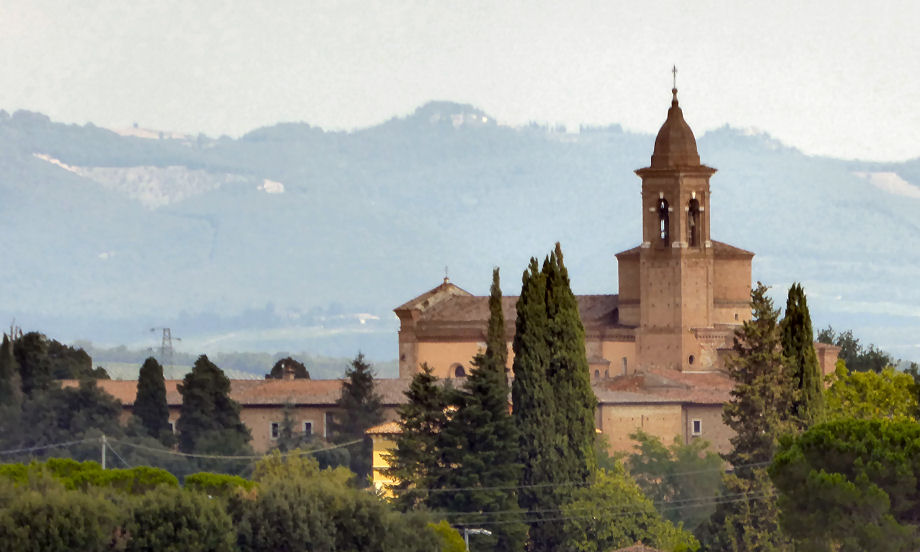
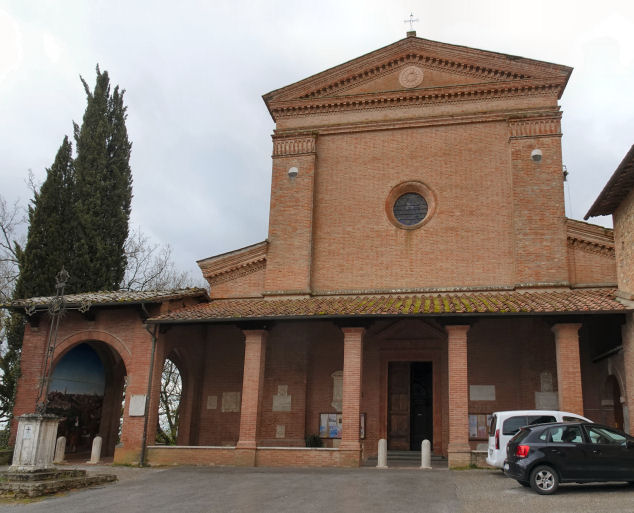
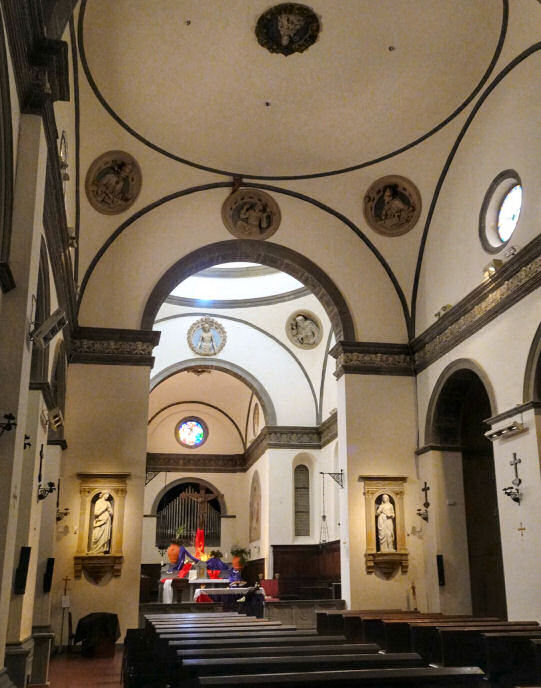
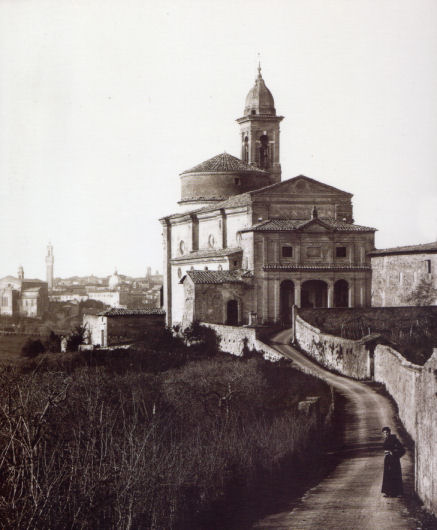
A photo from around 1890, before the destruction by bombing
and the
rebuilding of the 1940s (Alinari)
|
|
San Bernardino
and the Museo Diocesano
Via Vallerozzi |
History
An oratory of the 15th century, the seat of
the Compagnia di
Santa Maria degli Angele della Veste Nera, built on the site where Saint
Bernardino Albizzeschi preached, next to San Francesco. His sermons, which
could last up to three hours, became so popular that they had to be moved
to the Campo because of the crowds. Appropriately enough these sermons
often used mentions of the altarpieces and frescoes in Siena. Such was his
preaching command that audiences reached 30 thousand, it is said, despite
his having lost all of his teeth by the age of 40. Following Saint Bernardino's
canonisation in 1450 the confraternity added his name to their list of
saints they specially venerated, and decided to decorate their oratory in
his honour. But it took them a while, before they commissioned the three
artists mentioned below, as mentioned in a document of 1518. The travertine portal
is dated 1574.
Interior
The ground floor (entrance) chapel has scenes from The Life of San
Bernardino painted in the 17th century by Ventura Salimbeni, Rutilio
and Domenico Manetti, Crescenzio Gambarelli, Bernardino Mei and Deifebo
Burbarini, a pupil of Raffaello Vanni.
The ceiling fresco with a view of Siena, Arcangelo Salimbeni's The
Virgin Protecting Siena with Saints Bernardino and Catherine was
completed in 1580 by Francesco Vanni.
In the oratory upstairs (see
below right) the carpentry is the work of by Ventura Turapilli (after
1496), who later became capomaestro at the Duomo. It has fourteen large frescoes, looking harmonious and bright, of the
Life of the Virgin. Sodoma painted the Presentation middle left,
the Visitation end
right, the Assumption first right over the door, and the Coronation
on the back wall. Sodoma's pupil Beccafumi painted the Marriage last left and
Assumption middle right, as well as the Virgin and Saints, with Saint Bernardino
altarpiece, flanked by an Annunciation by Girolamo del Pacchia.
These were painted between 1496 and 1518, with Beccafumi's Visitation
and Assumption dating to 1525-9, and his altarpiece to 1535-7. There are also saints in the corners, three by Sodoma and one by Pacchia. The Birth, Presentation and Marriage feature a fine cat and two enthusiastic white dogs, respectively.
Sodoma was known for being surrounded by beardless youths, from which
repute he gained his nickname, but also for having a menagerie of odd
animals, including a badger and a crow which he taught to imitate his
voice. It's therefore tempting to suggest that these animal presences in
his works were his own additions.
There's a late-14th-century antiphonal in a glass
case at the back, illuminated by Lippo Vanni.
The attached
Museo Diocesano consists of five small rooms containing religious art from the 13th to 17th
centuries, all well-displayed. The collection includes works by Vecchietta, Ambrogio Lorenzetti and Matteo di Giovanni.
Lost art
The severely cut down Virgin and Child with two Angels
panel of 1262 (the Madonna di San Bernardino) now mostly accepted as by Guido da Siena
(Guido di Graziano),
or Dietisalvi di Speme, (who is known to have collaborated with Guido) was owned by the Compagnia di Santa Maria degli Angeli and kept here. It is now (no.16) in
the Pinacoteca. The fact that Guido is not mentioned as an artist until
1278, as well as stylistic issues, cast some doubt on this attribution,
however.
Saint Anthony and the Miracle of the Mule, Saint Francis Receiving the
Stigmata and Saint Bernardino Preaching, are predella panels
from the altarpiece here, which is till in position, by Domenico Beccafumi,
all of them now in the Louvre. Of this altarpiece Vasari says 'he resolved
to do it in distemper; and in this way he executed it excellently well,
painting in it Our Lady with many Saints. In the predella, which is very
beautiful, and painted by him likewise in distemper, he depicted S.
Francis receiving the Stigmata; S. Anthony of Padua, who, in order to
convert some heretics, performs the miracle of the Ass, which makes
obeisance before the sacred Host; and S. Bernardino of Siena, who is
preaching to the people of his city on the Piazza de’ Signori.' The panels
were removed in the 19th century and were acquired by the
Louvre in 1966.
Opening times
March 1st to October 31st from 1.30pm to 7.00pm (last admission 6.30
pm)
but admission is only with an OPA Si Duomo Complex pass.
|
|
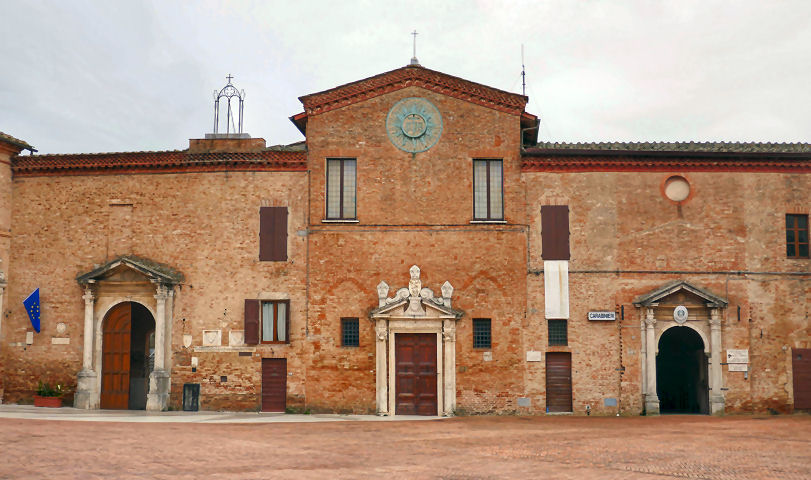
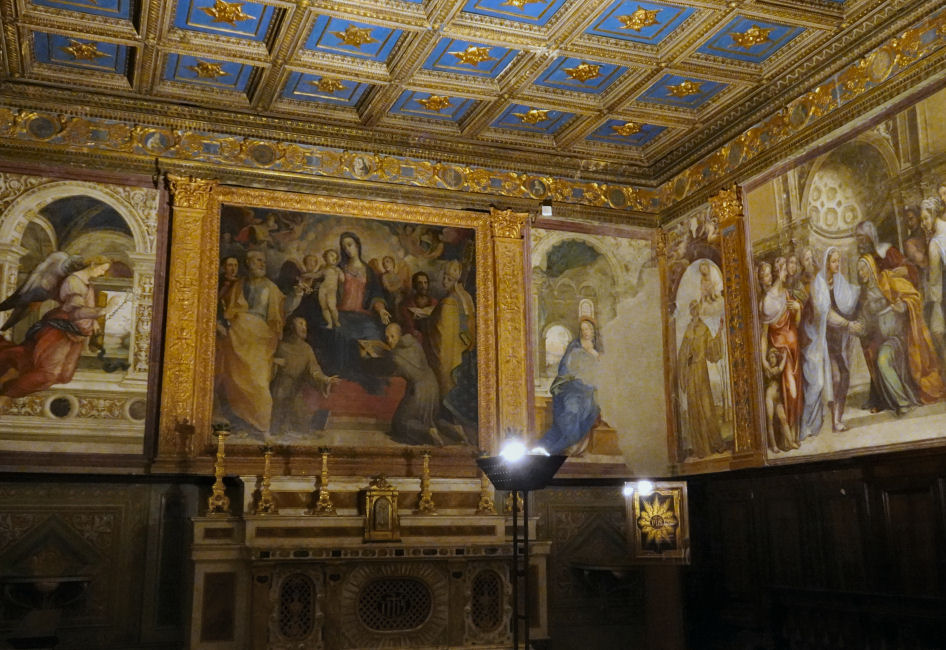 |
|
San Cristoforo
Piazza Tolomei |
History
A church with Romanesque (11th/12th-century) (or even Roman)
origins but rebuilt after the earthquake of 1798, when the façade
collapsed. The building was shortened at this time, with a neoclassical
brick façade added in 1800.
The church's cloister
was used for commune meetings before the building of the Palazzo Pubblico,
as was San Pellegrino, and the Duomo. So it was here, in 1260, after a meeting with Florentine ambassadors, that the Gran Consiglio made the decision to go to battle
with the Florentines at Montaperti. which proved to be such a historic
victory for the Sienese. Following the subsequent decision to hire
German mercenaries Salimbene Salimbeni, who was a banker and founder of
the early version of the future Monte dei Paschi, walked home to his
nearby palazzo and returned here with the wheelbarrow full of 118,000
florins, an event illustrated in the illumination below (ms. A.IV.5,
Siena, 1444).
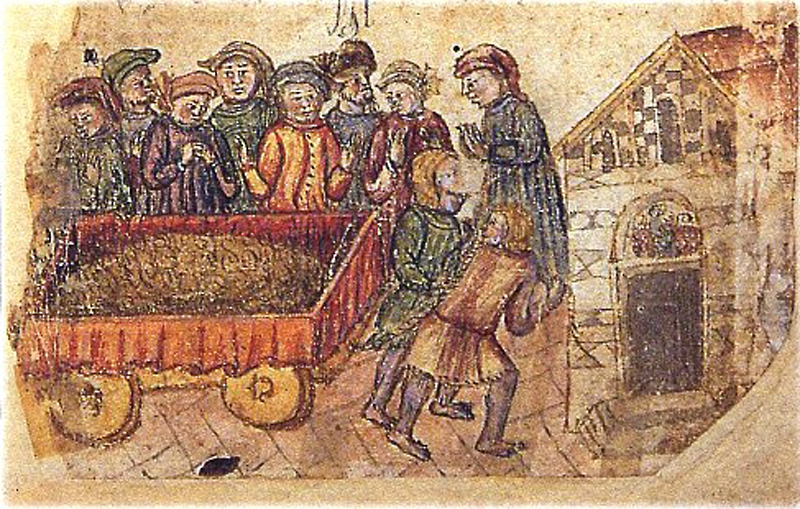
It is also said that in 1376 Saint
Catherine of Siena forced a reconciliation here between the feuding Maconi and
Tolomei families. This she achieved by going into an ecstatic trance
whilst praying before the altar.
From 1796 to 1945 the church was also the
headquarters of the Contrada della Civetta, who still have the patronage
on the first altar on the right, dedicated to Saint Anthony of Padua, the
patron saint of the contrada.
The façade
The temple-front façade of 1800 was designed by Tommaso and Francesco
Paccagnini and would originally have been covered with painted plaster.
The two statues of 1802 are of Bernardo and Nera
Tolomei by Giuseppe Silini. Bernardo was the founder of the Olivetan order
in 1313 along with two more members of noble families from Siena, Patrizio Patrizi and Ambrogio Piccolomini. The impressively gothicly looming Palazzo Tolomei (now a bank) is
directly
opposite the church.
Interior
Aisleless and pale inside, due to plain white walls.
The buff-colour columns and pilasters separate three arched bays each side, with
a real or trompe l'oeil
clerestory window in each.
Two altars face each other in the centre of left and right walls of the
nave. On the right there's a carved Crucifix with a painted standee of a bishop saint. On the left a dull but
serene Virgin and Child with Saints Luke and Romuald (c.1508) by Girolamo
del Pacchia. There is a reproduction of the Saint George panel (see
Lost art
below) in the last bay on the right,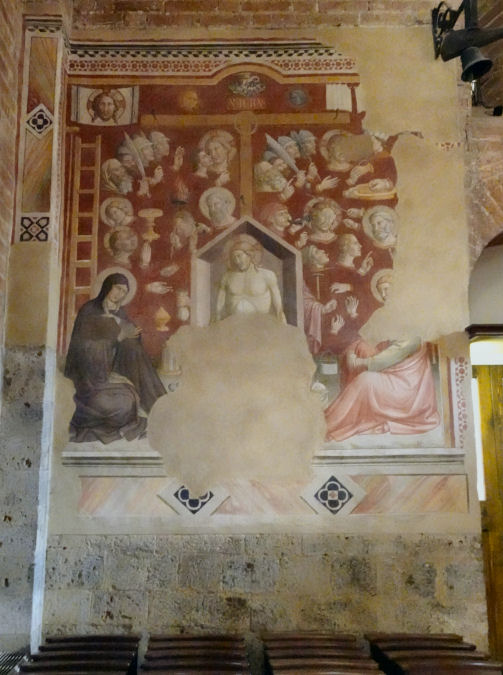 with
another reproduction, an accompanying same-height narrow panel of
Saint Christopher. The latter panel is now not thought to be from
the same polyptych. with
another reproduction, an accompanying same-height narrow panel of
Saint Christopher. The latter panel is now not thought to be from
the same polyptych.
The domed sanctuary is part of a small transept, attractive with exposed
brick suggestive of Romanesque origins. On the marble high altar in the
shallow apse is a marble sculptural group of
The Glory of Saint
Christopher by Giovanni Antonio Mazzuoli from 1693, flanked by candle-bearing angels. This group came from the Olivetan monastery of San
Benedetto ai Tufi, after it was suppressed by Napoleon in 1808 and
demolished
Hidden in the left transept is a
fresco of the Pietà with the Instruments of the Passion by Martino di
Bartolomeo (see right).
Lost art in the Diocesan Museum
A primitive-looking late-13/early-14th
century tondo of the Virgin and Child by the Maestro degli
Aringhieri.
The Saint George and the Dragon altarpiece painted by Sano di Pietro in the
1440s (see right) in remembrance of Giorgio Tolomei, who had been a
rector here, for the family chapel here, is now in the Diocesan museum
and the Vatican. It has also been attributed
to the Master of the Osservanza (who is now often said to be Sano di
Pietro) and to both of them working together, by scholars who think
them separate artists. The dragon is striped with half-moons, a symbol of
the Tolomei family. Two panels from a predella are in the Vatican Museum,
one showing Saint George Preaching to the King of Silena the other
Saint George Baptising the King of Silena. In the same room in the
Diocesan Museum is a same-height narrow panel of Saint Christopher,
by the same artist and from this church but now not thought to be from the
same polyptych.
A 15th-century della Robbia Virgin and Child and a tondo of the Virgin and Child by the Master of San Pietro a
Ovile.
Opening times
Daily 7.00 - 12.00 & 15.30 - 19.00
|
|
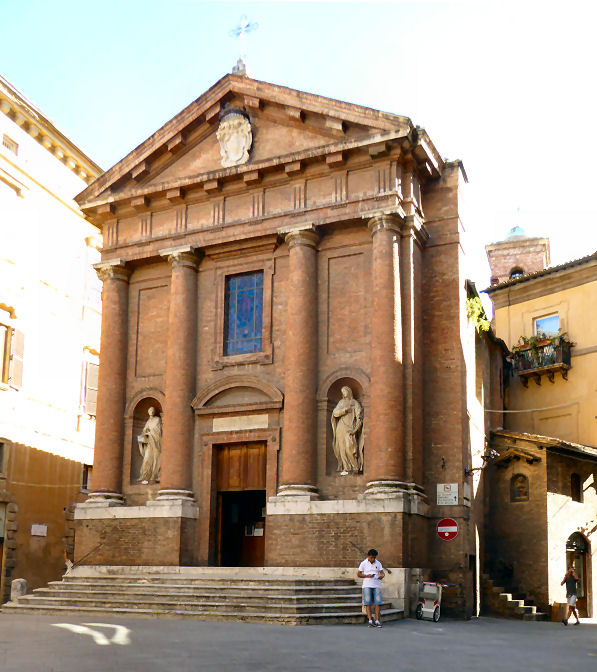
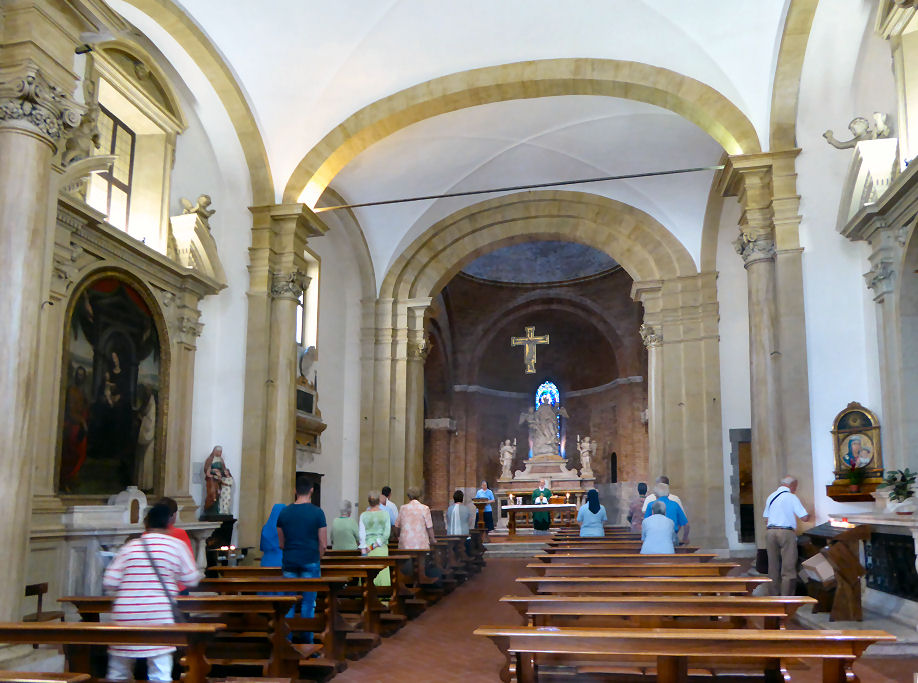
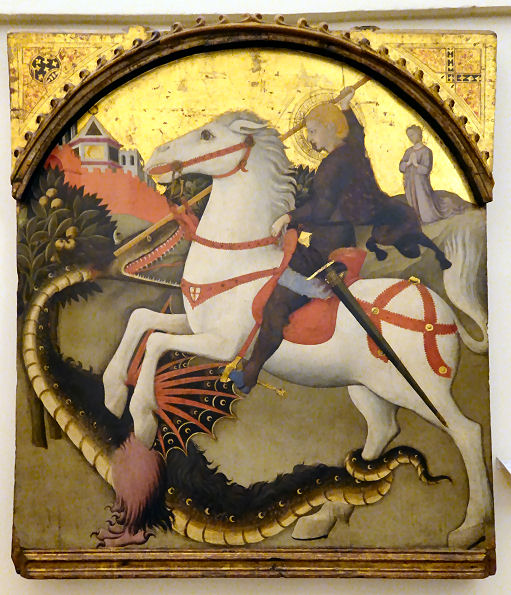
|
|
San Domenico
Basilica Cateriniana
Piazza San Domenico |
|
San Francesco
Piazza San Francesco |
|
this church now has its own page
|
|
this church now has its own page
|
|
San Donato
Monte de Paschi di Siena (bank)
Piazza dell'Abbadia |
|
San Gaetano di Thiene
oratory -
Via dell'Oliviera |
|
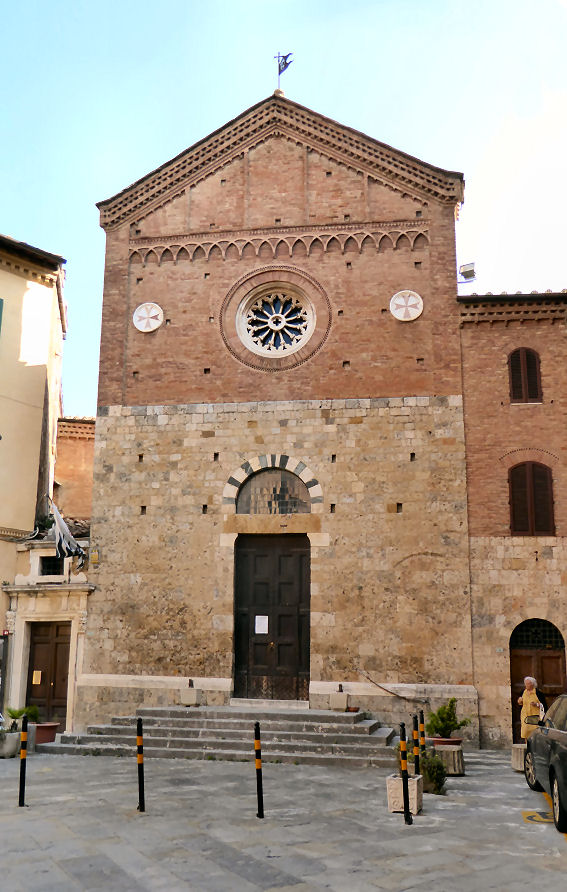
History
Built in 1119 as the Abbadia di San
Michele, passing swiftly to the Vallombrosans and in 1565 to the Cavalieri
di Santo Stefano. These last two orders have their coats of arms over
door. By 1682 it had passed to the Carmelites who did much work on the
church.
Interior unvisited
On the right wall as you enter are fresco
fragments possibly from the 12th century church.
Lost art
A 1409 altarpiece centred on the main-panel Annunciation by
Taddeo di Bartolo, which is flanked by full-length panels depicting the
doctor Saints Cosmas and Damian. It is in the Pinacoteca, where
there are also three of the four predella
panels, depicting The Adoration of the Shepherds, The Adoration of the
Magi, and The Crucifixion and Stoning of Saints Cosmas and Damian.
It would have stood on the Rossi family altar here, they having had many
medically-employed members.
A Crucifix signed and dated 1345 by Niccolò di Segna, now in
the Pinacoteca. It is said to come from 'the Vallombrosan church of Santi
Michele Arcangelo e Benedetto' which seems to fit with here.
A Pieta carved in walnut and polychromed,
an early work by Vecchietta from c.1448, is now in the diocesan museum in
San Bernardino. It was rediscovered
in this church only in the 1980s despite having been seen and described
here by Fabio Chigi in 1625–26. He also reported a now-lost inscription
‘hoc opus fecit Laurentius dictus Vecchietto pro sua devotione’. In this
sculpture Christ's dead right foot still crushes the female-headed serpent
of original sin.
Opening times
Monday to Saturday: 4.00 - 7.00
but was never open when I tried
|
|
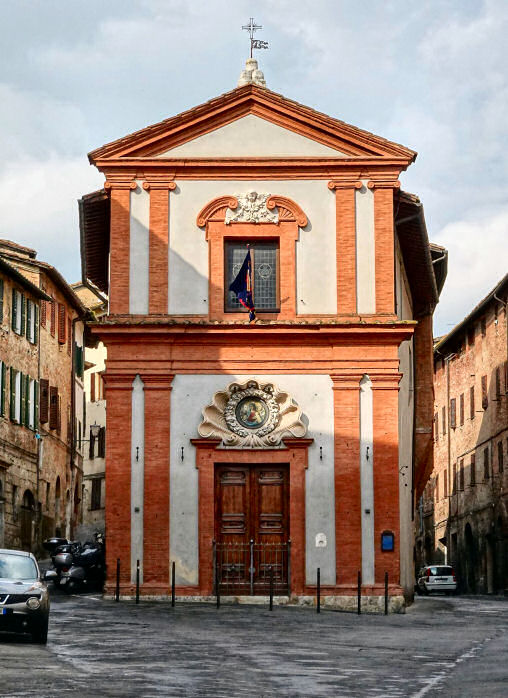
History
Oratory built 1683-1700 for the Contrada del Nicchio
(seashell). On the façade was a venerated early 14th century painting of the
Madonna of the Pitchfork in a shell shaped stucco niche, now replaced by a
copy. The contrada museum and headquarters are behind the church. Before
the Palio races of 2nd July and 16th August the blessing of the contrada's horse takes
place inside the Oratory.
Interior unvisited
The ceiling was frescoes are The Theological Virtues by Giuseppe
Nicola Nasini
and Stefano di Francesco Marzi, his pupil; the work being completed in
1734 by Apollonio Nasini to his father Giuseppe's designs.
Stucco work of 1686 -1705 by Giacomo Franchini, including statues of
the Blessed Ambrogio Sansedoni, in the first niche on left, and
San Gaetano (Saint
Cajetan) in the second niche on the left. On the right are Saint Vincent Ferrer and
The Blessed Giovanni Colombini. Beside the altar are Saint Bernardino and
Saint Catherine of Siena.
The high altarpiece of San Gaetano of Thiene Persecuted During the Sack
of Rome of 1825 by Luigi Boschi recently returned here
following restoration.
Opening times Rarely

|
San Giacinto
Via dei Pispini |
|
San Giacomo
Via di Salicotto |
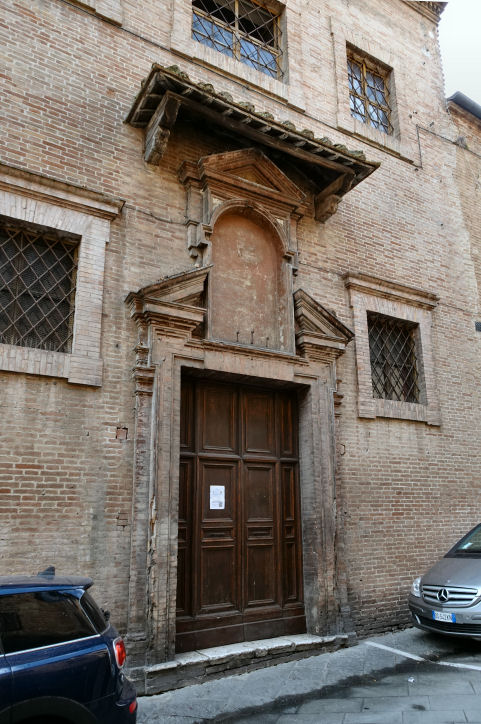
History
Named for Saint Hyacinth, a 13th century
Polish Dominican missionary. This church was attached to a Dominican convent, called of
San Giacinta di Vita Eterna,
where the nuns ran an adjacent orphanage. In 1528, it became the oratory of
the Confraternity of Sant'Emidio, a lay confraternity which still exists.
The church was deconsecrated and is now used by a Romanian congregation.
The convent became a home for poor widows in 1852.
Interior unvisited
Above the door in the plain brick façade is a weathered fresco by
Francesco Rustici (il Rustichino), who also painted the high altarpiece
inside - Saint Hyacinth Healing the Two Blind Boys,
signed 1615, for which a drawing exists in the Ashmolean Museum in
Oxford.
On the right is an altarpiece depicting the Mystic Marriage of
Saint Catherine of Siena by Cristofano and Vincenzo Rustici, the uncle and
father respectively of Francesco. On the left is a Madonna del Rosario
sometimes attributed to Niccolo Nasini, but also said to be a 17th-century
copy of a lost original by Fra’ Paolino da Pistoia or Bartolomeo della
Porta.
Above the door to the convent is a fresco of The
Virgin attributed to il
Brescianino.
Opening times Rarely
|
|
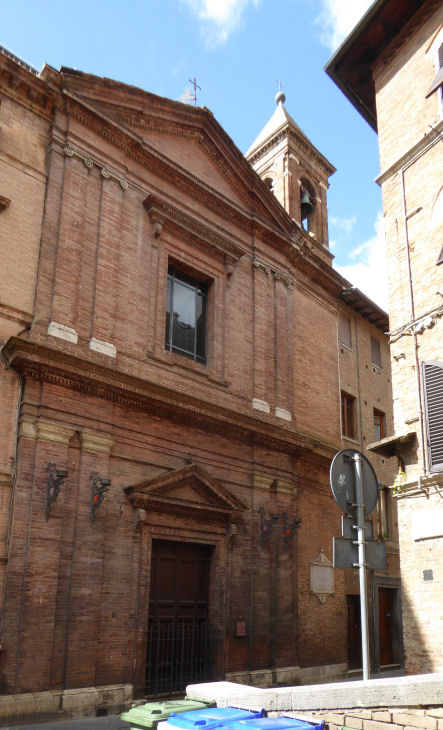
History
The original church here
was built between 1532 and 1536 to commemorate victory over the papal and
Florentine troops in the Battle of Camollia of 1526 The battle took place
on the 25th of July 1526, which was the feast day of St. James the
Greater, hence the naming of the church. The original 16th-century church
was rebuilt c.1665 and reconsecrated in 1702, on the 25th of July 25 of
course. The façade was also rebuilt during this work but this work was
reversed in the late 19th century by Sienese architect Giuseppe Partini .
Now the
Oratory of the Contrada della Torre (tower).
Interior
unvisited
Aisleless. The vault fresco is the Glory of Saint James (1700/02) by
Dioniso Montorselli with stucco work by Iacomo Franchini from the same
period. The oldest work here is a Virgin and Saints James and
Christopher (c.1545) by Giovanni di Lorenzo, on an altar on the
right. This work celebrates the battle of Camollia on July 25th as
this is the feast day of Saint Christopher as well as of Saint James.
On the high altar is the Martyrdom of Saint James, signed and dated
1605 by Rutilio Manetti. There's also a Crucifixion from the
Certosa di Maggiano, from 1625. Also some late 17th century works mostly
also celebrating Saint James, after whom the church is named.
The adjacent contrada museum has Sodoma's Way to
Calvary from c.1546, thought to be one of his last works.
Campanile
1901, attributed to
Agenore Socini who also built the church of
Sant'Elisabetta della
Visitazione.
Opening times Rarely
|
San Giorgio
Via di Pantaneto |
|
San Giovannino della Staffa
Piazetta Virgilio Grassi |
|
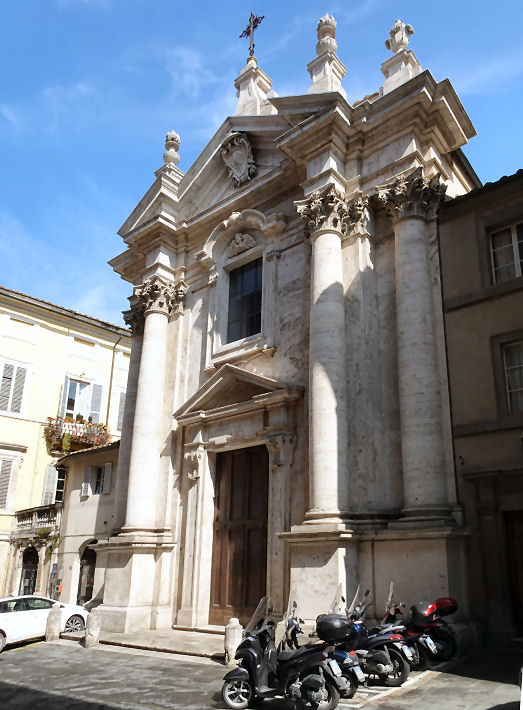
History
Tradition has it that there's been a church here since the 11th century
and that the church was then rebuilt with donations from the German
mercenaries who fought alongside the Sienese in the Battle of Montaperti
in 1260 against the Guelf Florentines, where it is said the Sienese side
had called on Saint George for help. The current Baroque church is the
work of Pietro Cremini, was consecrated in 1731 and finished in 1738.
The travertine marble façade features the coat of arms of Cardinal Anton
Felice Zondadari, the patron of the rebuilding. In the transept are the
tombs of two member of the Zondadari family.
Interior unvisited
There's a Crucifixion
with Father Matteo Guerra
of 1601-2 (see below) on the second altar on the left and a Pietà with Saint
Catherine in the right transept, both by Francesco Vanni, who is buried here
-
his polychrome tomb of 1656
is to the left of the main door on the inner façade. His bronze bust here is the
work of his sons Raffaello and Michelangelo, the latter also being
responsible for the marble panel.
Michelangelo
 Vanni, the elder son
is said to have completed the Crucifixion with Father Matteo Guerra,
while the Encounter of the Lord with his Mother on the Calvary was painted
by Raffaello Vanni. The high altarpiece depicts Saint George and the Dragon
by Sebastiano Conca. Vanni, the elder son
is said to have completed the Crucifixion with Father Matteo Guerra,
while the Encounter of the Lord with his Mother on the Calvary was painted
by Raffaello Vanni. The high altarpiece depicts Saint George and the Dragon
by Sebastiano Conca.
Campanile
Hard to see. Romanesque of 1260. It has 38 windows, the same as
the number of
campaigns fought against the Florentines, or of the companies of knights who took part in the Battle of Montaperti,
where Siena defeated Florence and which was fought in the year it was
built.
Lost art
An Immaculate Conception by Ventura Salimbeni, half-brother of
Francesco Vanni, is now in the Diocesan Museum.
Opening times Rarely
|
|
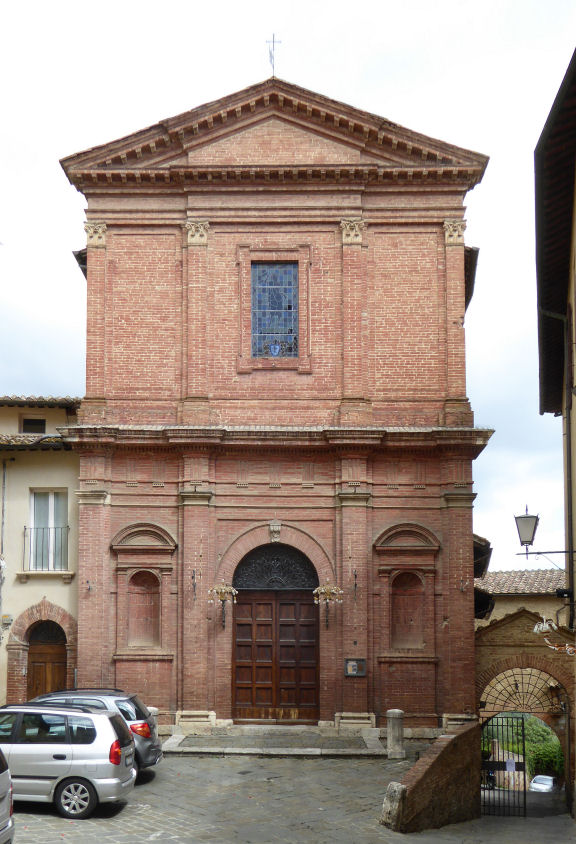
History
Legend has it that the original building on this site was an ancient
temple of Jupiter.
A 13th century Romanesque church here was rebuilt in the first half of the
16th century. It was dedicated to St John the Baptist, for the lay company
of of St. John in Pantaneto. The architect was possibly Giovanni
Battista Pelori, a pupil of Baldassarre Peruzzi, who may have been
responsible for the initial conception. The brick facade was completed by
1537, but the completion of the body of the church wasn't achieved until
the 1590s. Fresco decoration inside was commissioned from 1590 to 1650.
The church was consecrated on the 10th of May 1611 by the bishop of
Grosseto, Cesare Ugolini. The Contrada del Leocorno has been associated
with the church for more than three centuries.
Interior
unvisited
The nave ceiling vault fresco is the Glory of St John the Baptist by Dionisio Montorselli. Above the wood panelling of the choir around the
nave are thirteen framed canvases by various artists, depicting
Stories of the Life of John the Baptist. The painters include Dionisio
Montorselli (the Annunciation), Rutilio Manetti (four canvases
including Christ Blessing the Young Saint John the Baptist of
1599/60 - a rare, possibly unique, use of this subject as an
altarpiece - and the high altarpiece of The Baptism of Christ (which
Manetti had to come back and enlarge after the installation of the new
altar in 1609), John the Baptist declares Christ to the Pharisees),
Domenico Manetti, Giovan Battista Giustammiani, called il Francesino, (Burial
of John the Baptist) Bernardino Mei (Beheading of the Baptist), Raffaello Vanni (Saint Zacharius at the Temple), Deifebo Burbarini (Saint
Francis), and Astolfo Petrazzi (Beheading of Saints John and
Ansano). Some works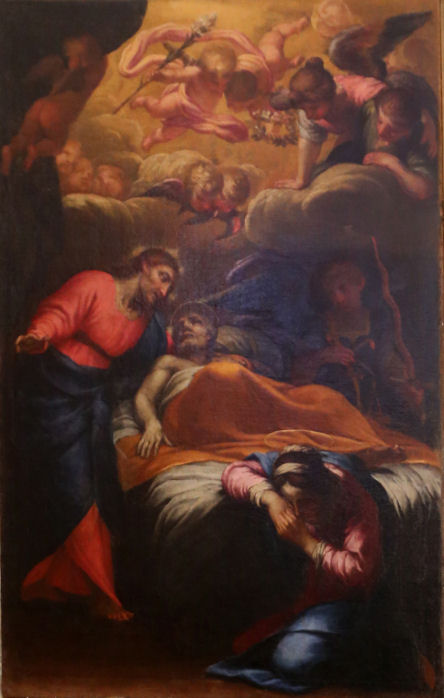 have been attributed to Angelo di Niccolò Tegliacci (The Baptist led to Prison), Cristoforo Rustici, Niccolo
Nasini, and Tornioli (The Banquet of Herod). have been attributed to Angelo di Niccolò Tegliacci (The Baptist led to Prison), Cristoforo Rustici, Niccolo
Nasini, and Tornioli (The Banquet of Herod).
The polychrome marble high altar (1609) was built by Flaminio del Turco.
There is a small 14th-century Madonna della Pace by Francesco di
Vannuccio.
In the entrance hall is a terracotta statue of the Baptist by Guidoccio
Cozzarelli and a canvas depicting The Glory of Saint Joseph (see
right) by
Deifebo Burbarini, a pupil of Raffaello Vanni, who's also known as Deifobo
Barbarini, and various combinations thereof.
Opening times Rarely
|
|
San Girolamo
Via San Girolamo |
History
The first Gesuati convent in Siena, founded in 1354 by
Francesco di Pietro Porcari. The Gesuati order, which specially venerated
Saint Jerome, had been founded by Giovanni Colombini, who was from a
Sienese patrician family. The convent was enlarged in the following century,
financed by the comune. In 1428 building began on the present
church, with the first cloister following in 1469 and the second in1481.
In 1552/55 the convent was occupied and very damaged by the Spanish army,
but returned to the Gesuati friars shortly after. When the order
was suppressed by Clement IX in 1668 it passed to the Vergini Abbandonate
(Destitute Girls) and then in 1855 Duke Leopold II gave it to the French
order of nuns the Figlie della Carita di San Vincenzo de' Paoli,
who are still here.
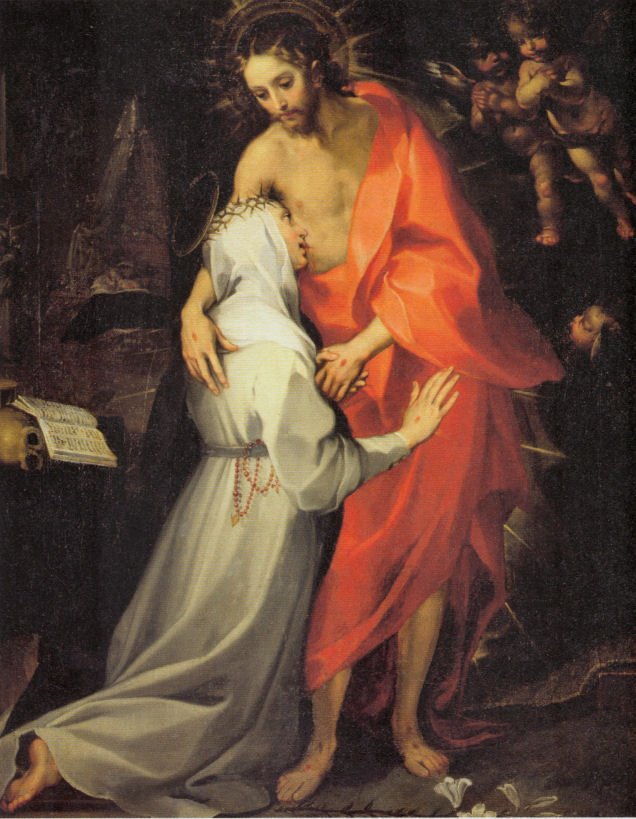 Interior unvisited Interior unvisited
Black and white striped interior. On the back wall of an antechamber left
of high altar is a Coronation of the Virgin by Sano di Pietro, who
became the order's go-to artist (see Lost art
below). The
Virgin is flanked by Saint Jerome and the Beato Giovanni Colombini, the
latter being the Sienese founder of the Gesuati order, the former his inspiration
- the order's full name was the Frati Gesuati di San Girolamo.
Colombini came from a wealthy Sienese
family but renounced worldly pleasures at 40, embraced poverty and
penitence
and later established the order.
A monochrome Crucifixion (1448?) by Michele di Matteo.
The
cloister contains a fresco of The Enthroned Virgin and Child, Two
Angels, Saint Jerome and the Blessed Giovanni Colombini by Fra Giuliano
da Firenze. An artist much influenced by Ghirlandaio, this is his only
known work. Bernardino Fugai painted the frescoes in the
surrounding niche.
A rare depiction of the
somewhat gross Saint Catherine of Siena Drinking the Blood from Christ's Wound
(see left) by Francesco Vanni
from 1594.
Lost art
The spectacular spiky-topped Polyptych of the Gesuati (246) (also known
as the Polittico del Beato Colombini) (right) by Sano di Pietro,
his first independent commission,
is in the Pinacoteca, but its predella, dedicated to the life of Saint
Jerome, is in the Louvre. It shows the Virgin and Child Adored by the
Blessed Giovanni Colombini and six angels. They are flanked by Saints
Saint Dominic, Jerome, Augustine, and Francis. In the pinnacles are
Saints Cosmas and Damian either side side of an Annunciation
pair and topped by a larger Blessing Christ. More saints are on the
lateral pillars. It is Sano's
earliest known signed work, commissioned in 1439 and completed 1444, when
he was nearly 40. It
underwent restoration for the 2010 exhibition “From Jacopo della Quercia
to Donatello: the Arts in Siena in the early Renaissance”. Sano also painted a
Virgin and Child with Saints, with a predella of
Episodes from the Lives of Saints Cosmas and Damian (233) in 1446.
Opening times Rarely
|
|
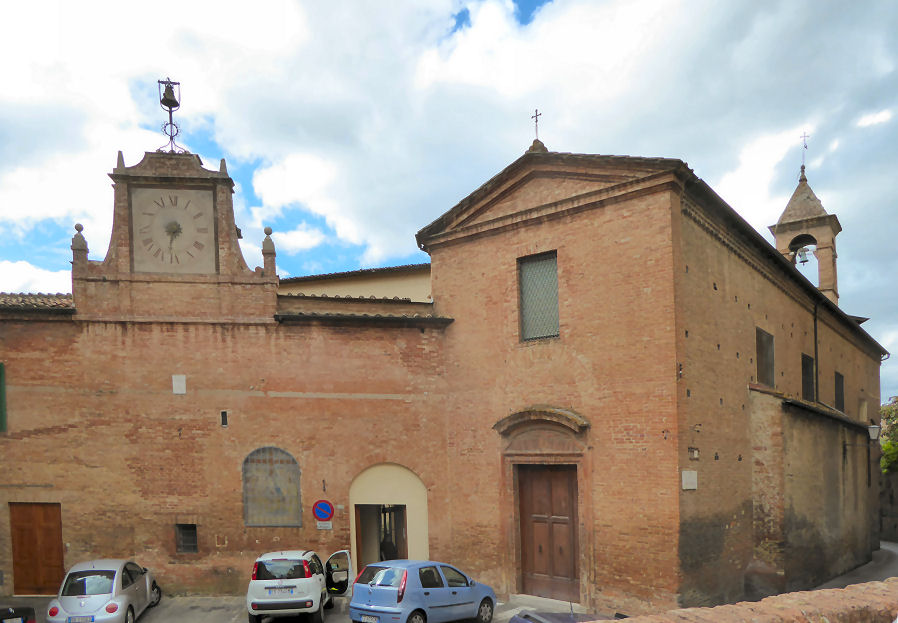
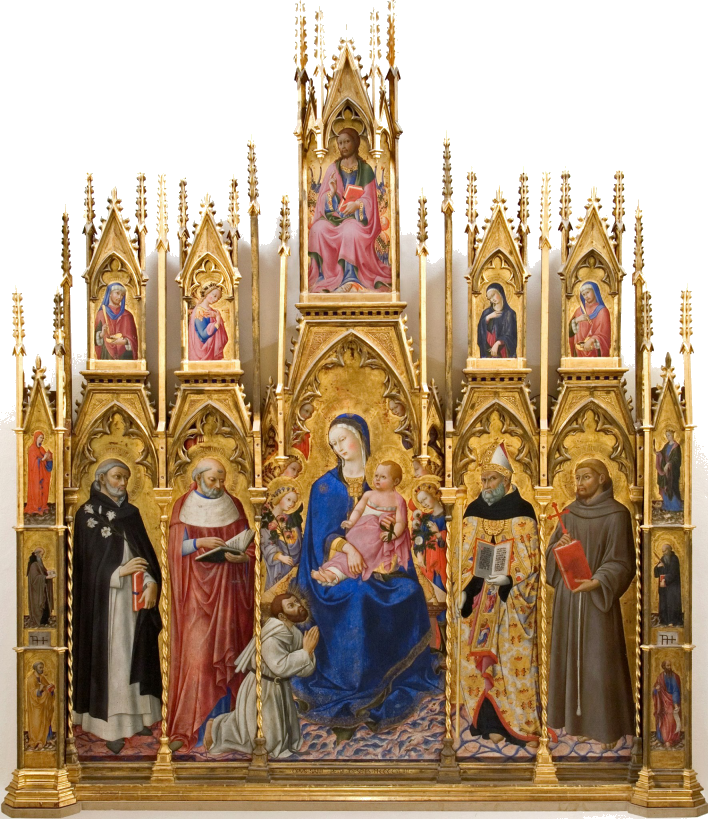
|
San Girolamo in Campansi
Via Campansi |
History
A baroque style church, part of a monastery
has been converted to a nursing home (Casa di Riposo) for the elderly.
Originally established by a group of Franciscan woman in the late
13th/early14th century. The republic gave them some houses here, a
district notorious for prostitutes. Only in the 1420s was a monastery
built and in 1473 the nuns obtained permission from Pope Sixtus IV to
build an oratory. In 1575 the convent housed some 77 women. Following
official recognition by Cardinal Metello Bichi in 1613 it soon became
popular amongst the aristocracy for the cloistering of daughters,
like Berenice, daughter of Agostino Chigi, who took the vows of the Poor
Clares in 1683.
Construction of the church began in 1683. It was built
perpendicular to the former oratory.
The convent was suppressed by
Napoleon in 1808, but re-opened in 1816, only to be finally suppressed in
1874. In 1889, it became 'an asylum for abandoned elders' and so has had
many modifications over the last two centuries.
Interior
A wide church, with no aisles and just a pair of side altars in shallow
niches. Very baroque but with tastefully dull gilding, with lots of big
angels and chunky putti. A lofty nuns' gallery at the back and screens in
the wall either side of the high altar.
The ceiling has
frescoes depicting The Glory of Saint Peter of Alcantara, The Glory of the Virgin,The
Glory of Saint
Francis, and The Glory of Christ by Giulio Coralli and Michelangelo
and Niccolò Ricciolini.
The high altarpiece is an 18th-century copy of Domenichino's Communion
of Saint Jerome.
The convent
The cloister has a fresco of the Annunciation attributed
to the studio of Sano di Pietro (1460). On the first floor there's a fresco of The
Virgin and Child with Saints Anne,
Ursula and Mary Magdalene, attributed to Domenico Beccafumi. Also
reported is a late 15th-century Assumption attributed to Pietro di
Domenico (the angel musicians, God the Father and the prophets) and Matteo
Balducci (the rest), Saint Francis Receiving the Stigmata by
Girolamo di Benvento and Jesus with the Samaritan by Il Riccio from
1540/50.
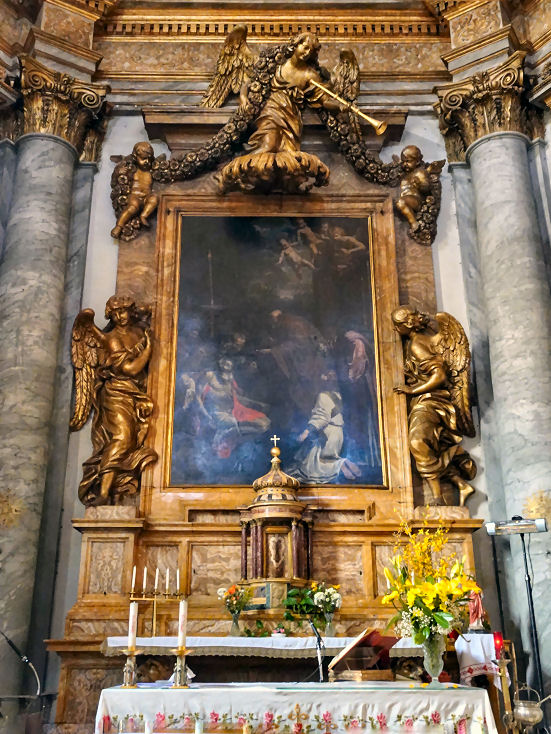
|
|
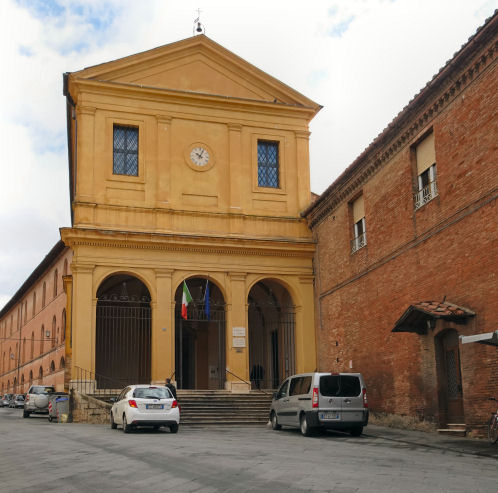
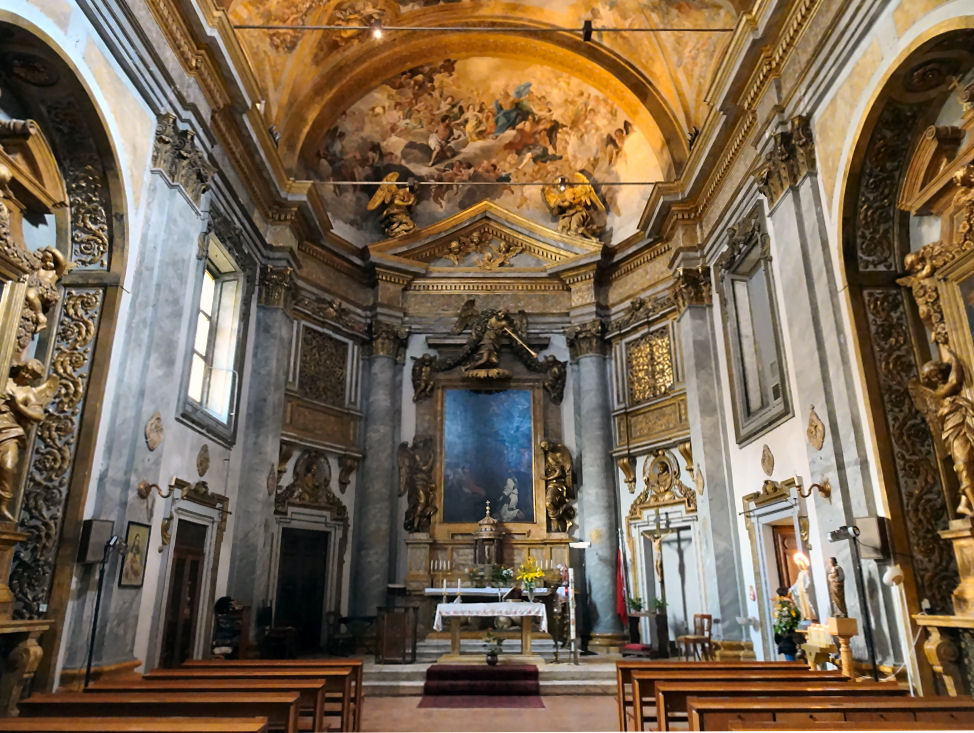
|
San Giuseppe
Via Giovanni Duprè |
|
San Leonardo
Via di Val di Montone |
|
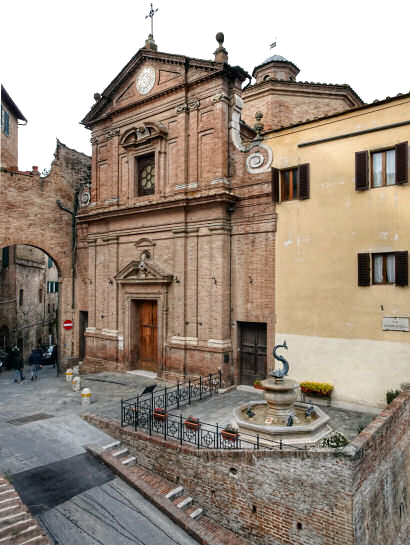
History
Since 1787 the oratory of the Onda (wave, symbol: dolphin)
contrada,
building began in 1521, overseen by Baldassarre Giusti .
The façade was finished in 1653 with a contemporary bust of the saint
by Tommaso Redi over door.
Interior
unvisited
A Greek Cross plan, topped by an octagonal dome
with a lantern, attributed to Baldassarre Peruzzi or Bartolomeo
Neroni called il Riccio.
The entrance vault is frescoed with The Life of Joseph by Apollonio
Nasini, from 1735. Impressive wooden furnishing, by Pietro di Austo
Montini between 1712 and 1720. The contrada's
museum and meeting hall is in the 16th-century crypt, which has an
octagonal vault and houses art and palios won by the contrada.
The church on film
James Bond's Aston Martin (but not that Aston Martin)
enters Siena through the archway to the left of San Giuseppe in the film
Quantum of Solace
Opening times Rarely
|
|
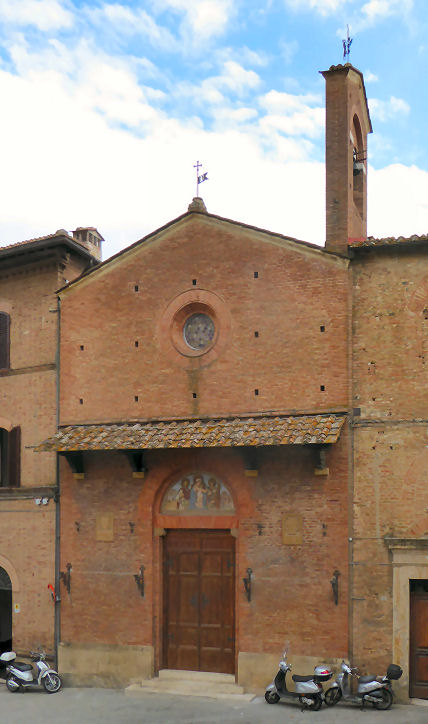
History
In
1173 the original small church here was occupied by the Order of Saint
John of Jerusalem, who later became the Knights of Malta. On their
suppression, the church was bought by Celso Bargagli who gave it to the
parish in 1818.
Having been severely damaged by the earthquake of 1798 it was restored in
1938 to designs by the Sienese architect Egisto Bellini, who remade the neo-Romanesque façade
and added the bell tower.
More work was carried out by architect Giovanni Michelucci from 1978, who set out to
restore the neoclassical interior with the removal of the altar and other
baroque fittings as well as general restoration and the creation of
a small museum of the Valdimontone (Valley of the Ram) contrada in the
loft area.
Opening times Rarely
|
|
San Martino
Via del Porrione |
History
Mentioned in an 8th century document, and
maybe founded even earlier. Present by the 12th century and renovated in
the 14th. Then part of a major remodelling of the district by the
Piccolomini, then benefiting from the election of Aeneas Silvius
Piccolomini (1405–64) to the papacy as Pius II in 1458. He sponsored three
major projects in the 1460s, the rebuilding of this church, the building
of the Logge del Papa next to the church and the Palazzo Piccolomini over
the piazza. The appearance of the current church however dates to interior
restoration in 1537 (just after San Martino passed to Augustinians from
the Observant Congregation of Lecceto) to designs by Giovanni Battista
Pelori, a pupil of Baldassare Peruzzi, with a baroque façade of 1613.
Interior
Aisleless, thick grey pilasters and arches between three
altars each side of the nave. Frescoed dome and spandrels over a
transept that's
taller but not deeper than the
side chapels. The barrel-vaulted apse
ceiling is decorated with a fresco.
The inner façade has a canvas depicting the
Immaculate Virgin Protecting the Sienese at the Battle of Camollia
by Giovanni di Lorenzo, commissioned by the city commune and signed and
dated 1528.
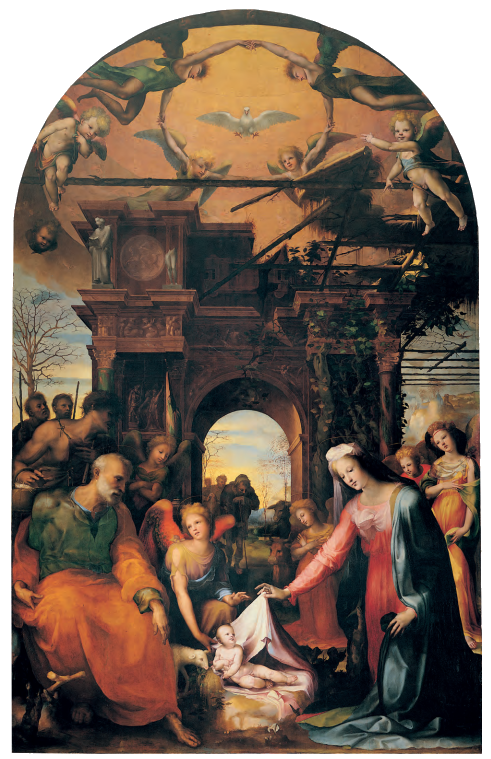 It
features a detailed battle scene around Siena in its bottom quarter. It
features a detailed battle scene around Siena in its bottom quarter.
The third altar on the left has a grand and glowing Nativity of 1522-4 by
Domenico Beccafumi,
called the Marsili Nativity (see right), set in a marble frame by
Lorenzo di Mariano (Il Marrina). It was commissioned by Anastasia Marsilia, the widow of Ugolino di Messer Minoccio (Ugolino
Ugolini) and painted
whilst Beccafumi was working on the Duomo's pavement. Vasari discussed the
Nativity as a milestone in Beccafumi's career, saying that it
established his independence from Il Sodoma, his master. Text carved on
the front edge of the step in front of the altar table here confirms
Anastasia Marsilia as the patron.
The third altar on the right has a late (1636) Circumcision by Guido Reni.
Guercino's Martyrdom of Saint Bartholomew of 1636 is on an altar to the left.
It began to deteriorate very quickly and is now so darkened as to be
better appreciated in a copy made by Giacinto Campana for Cardinal
Girolamo Colonna, Archbishop of Bologna. The Compagnia dei Disciplinati
della Madonna commissioned the painting from Guercino for the Mancini
chapel, Giulio Mancini having made the Compagnia primary beneficiaries
upon his deathin 1632.
The high altar has a spectacular ciborium by Giuseppi and Giovanni Antonio
Mazzuoli commissioned by the de' Vecchi family
A Virgin and Child by Neroccio was recently found here under
layers of repainting and restored and
unveiled at the Pinacoteca in 2010.
Local heretic
Brandino was a local religious fanatic, born
1486. Following a dissolute early life and fearing damnation he converted
and wandered around Italy. In Rome around Easter 1527 he made various
appearances, half-naked and with long tangled hair, condemning Pope
Clement VII as a 'bastard of Sodom' and predicting that 'God's wrath will
fall upon you and the city!' He was thrown in prison, but the Sack of Rome
just two weeks later proved his prophesy correct. He returned to Siena,
where following his death in 1554 his body lay exposed for veneration
three days in this church.
Lost art
A late 14th-century Madonna del Latte by Naddo Ceccarelli, now in
the Diocesan Museum.
A Crucifix signed and dated 1433 by Sassetta,
from the refectory here, sawn up at the end of the 18th century to make
doors, three fragments of
which are in the Palazzo Chigi-Saracini. The busts of Saint John and
the Virgin were on the arms of the cross, the famous Saint Martin
Dividing his Cloak with the Beggar was at the base.
A sculpted wooden group of five (six?) figures, of the Virgin with
Saints, by Jacopo della Quercia, moved to the Duomo's Museo dell'Opera
in 1980
Campanile
Finally finished in 1738
Opening times For services only |
|


|
San Niccolò al Carmine
Pian dei Mantellini |
History
The first documented proof of the Carmelites
here, and the building of a church dates to 1262. They had moved into and
restored a small church dedicated to Saint Nicholas, thereby ingratiating
themselves as respecters of ancient structures and local traditions, a
not-uncommon tactic of the mendicant orders. The five churches of the main
mendicant orders circle Siena. The current church was built for them
from the 14th century but given a renaissance remodelling in the next
century by Baldassare Peruzzi, who was responsible for the high altar in
the Duomo and made a name for himself in Rome for,
amongst other buildings, the Palazzo della Farnesina for Sienese banker
Agostino Chigi.
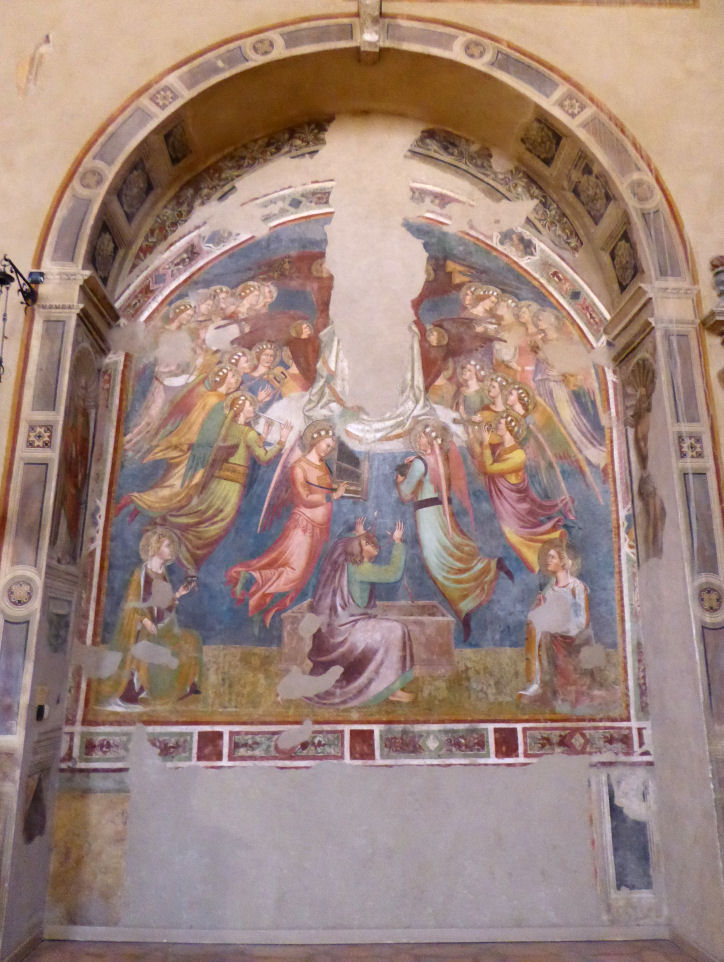
Interior
A tall single nave interior with a pair of altars in the middle either side
and a pair more alcoves towards the back.
The right wall altar has a stormy
Saint Michael and the Fall of the Rebel Angels from c.1528 by Domenico Beccafumi.
(His original version, even more mannerist and full of nude angels, was
rejected by the monks here. See
Lost art
below.) The predella is by Stefano Volpi.
To its left is an
ostentatiously framed fresco fragment of the Virgin from an
Annunciation
by Ambrogio Lorenzetti, it is sometimes claimed.
The right wall alcove is full of an
impressive lately-uncovered fresco of The Ascension (see right) damaged and missing its
Christ, by Benedetto di Bindo.
Not seen: an altar on the right has a venerated icon, the Madonna dei Mantellini
(c.1240) which gave its name to the area and street outside. The work goes
unmentioned until 1585, when Francesco Vanni made an altarpiece to
surround it (called a bildtabernakel) depicting Saints Albert,
Stephen, Martin and Catherine of Alexandria in Veneration (1598). Another Byzantine Madonna, the
Madonna del Carmine, (see below)
is reportedly also to be seen in this church.
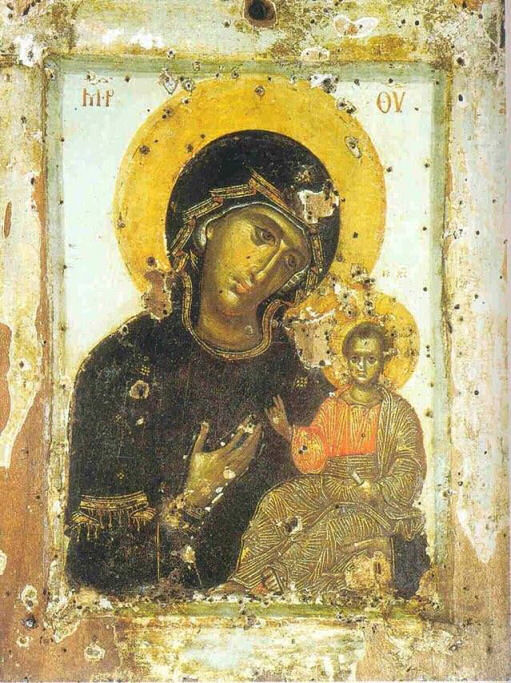 The left wall altar has a panel of The Ascension by Girolamo del
Pacchia
with a three panel predella depicting the Annunciation to Joseph, the
Flight
into Egypt and the Adoration of the Magi. The left wall altar has a panel of The Ascension by Girolamo del
Pacchia
with a three panel predella depicting the Annunciation to Joseph, the
Flight
into Egypt and the Adoration of the Magi.
There are some
17th century panels about the place.
To the right of the apse is the door
to the Chapel of the Sacrament with a painting by Sodoma of God the
Father and the Birth of the Virgin which when I visited (September 2016)
was away
being restored.
The sacristy evidently has a polychrome terracotta statue of
Saint Sigismund by Giacomo Cozzarelli and an Annunciation by Raffaello
Vanni.
(A Nativity by Bartolomeo Neroni
(Il Riccio),
but finished by Arcangelo Salimbeni (1565-79) on the right nave wall. The
Martyrdom of Saint Bartholomew of 1604, a late work by Alessandro
Casolani (he died in 1607), his masterpiece it is said)
Lost art
A damaged 13th-century Virgin and Child panel
(La Madonna del Carmine see left) is in the
San Bernardino diocesan museum.
Of the large and marvellous Pala del Carmine high altarpiece
painted by Pietro Lorenzetti (signed and dated 1329 on the throne base) (see
right) the central panel, the Virgin and Child
with Saint Nicholas and the Prophet Elijah and the far flanking full-length standing
figures of Saints Catherine and Agnes are in the Pinacoteca,
with the central-panel-flanking Saint John the Baptist and Elijah panels now in the
Norton Simon Museum in Pasadena. The impressive predella (depicting episodes from the
history of the Carmelite order, including apocryphal Old Testament
episodes) and two pinnacles are also
in the Pinacoteca. Another pinnacle is in the Yale University Art Gallery and at
least one is
missing. They depict pairs of apostles. The dispersing was because, what
with the Counter-Reformation and changes in taste, the altarpiece was
sent, without two side compartments, to the church of Sant'Ansano a Dofana.
At this time the prophet Elijah, claimed by the Carmelites, to the right of the Virgin, was repainted
as Saint Anthony Abbot. The panels that remained in Siena soon ended up on
the market.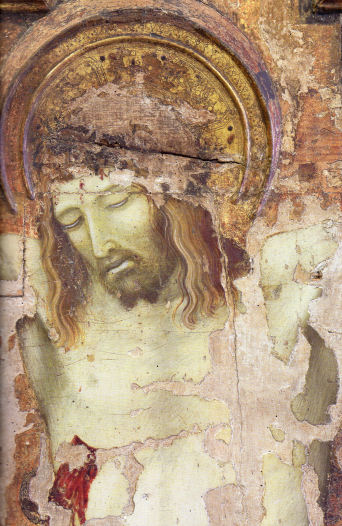
A very damaged Crucifix of c. 1329,
previously thought to be by Pietro Lorenzetti but now ascribed to Ambrogio, is also in the
Pinacoteca. It was found to be in a deplorabile stato when the
church was suppressed, and underwent restoration for the 2017/18 Ambrogio
Lorenzetti exhibition in Siena but still looked very rough (see detail
right). In May 2020 it was announced that it had gone to Florence for
more restoration work and in March 2021 it was revealed that 'the first
phase of the restoration...is starting to conclude'.
Also in the Pinacoteca is Bernardino Fungai's Virgin and Child
Enthroned, with Saints Sebastian, Jerome Nicholas and Anthony of Padua (1512),
his only signed and dated work. So all the scholarship on Fungai flows
from this work. Some predella panels in the Howard University Gallery of
Art in Washington are said to be parts of this altarpiece.
Christ Suffering and Christ Triumphant by
Giovanni di Paolo (see far right) from the early 1420s, originally
commissioned by Francesco Bellanti, Bishop of Grosseto for his chapel in
San Domenico. The demon painted in the scene below the triumphant
Christ's feet has been defaced, the word 'demon' inscribed on his chest.
In even odder graffiti the three souls in purgatory to the left of the
devil have had their heads crossed out and their bodies numbered III, II
and I. This panel and a polyptych of 1453 by the same artist for the high
altar here are also in the Pinacoteca.
The original and unfinished version of
Saint Michael and the Fall of the Rebel Angels from c.1527 by Domenico Beccafumi,
even more vigorous and full of flexh than the one over the right-wall
altar (see above) was
rejected by the monks here and is now in the Pinacoteca. Vasari described
it as ‘una pioggia d’ignudi molto bella’ (a rain of lovely nude figures)
and said that it was placed in Santa Maria della Scala in 'a room near the
high altar at the top of the stairs'.
Campanile
Recently attributed to Peruzzi too, but some scholars think it
17th century.
Cloister
Late
16th century with frescoes depicting The Carmelite Rule by Giuseppe Nicola Nasini of 1710. Can be
entered Via no.4 Via della Diana and now offers somewhat spartan, it
seems, tourist accommodation.
Filippo Lippi connection
Fra Filippo Lippi, the Florentine artist, was sub prior here
early in his career, from November 1428 to August 1429, so exciting
art historians in their conjectures about the direction of the flow
of inspiration between artists in Siena and Florence.
Opening times Monday to Saturday: 4.00 - 6.30
I found the church open one evening in 2016 and staffed by a very helpful
and knowledgeable student from the university next door. But I've
since learned that I was very lucky, and indeed I never found it open
during two subsequent stays.
|
|
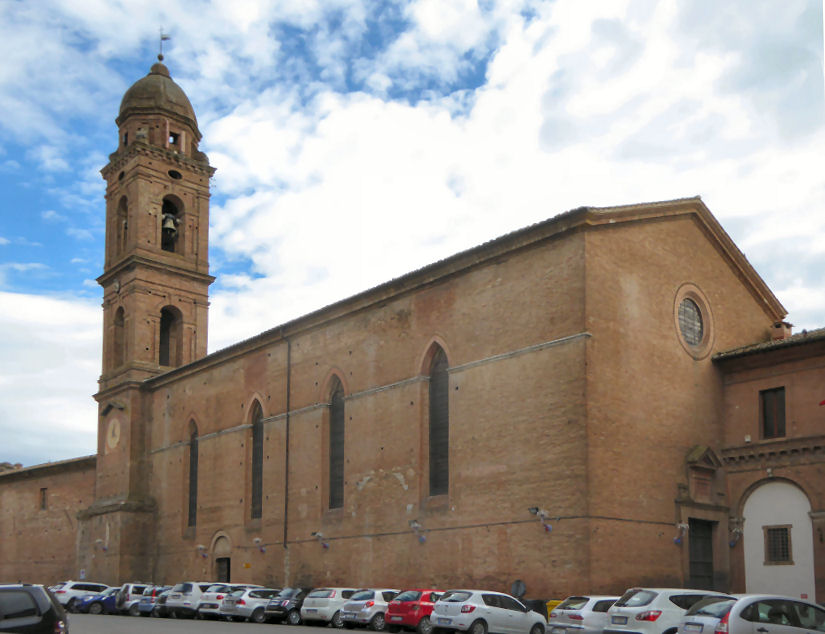
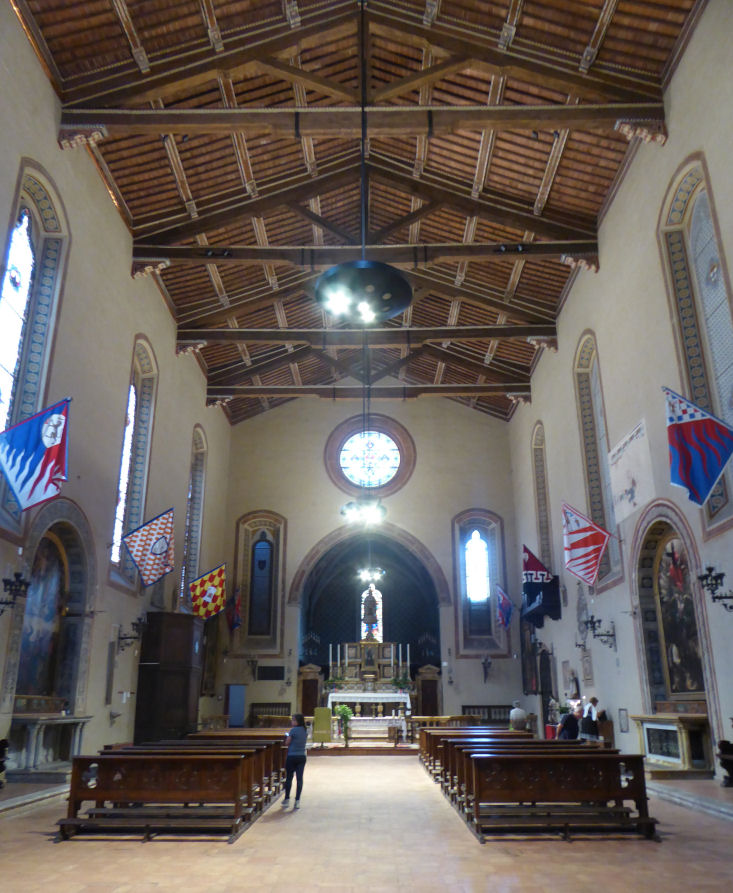
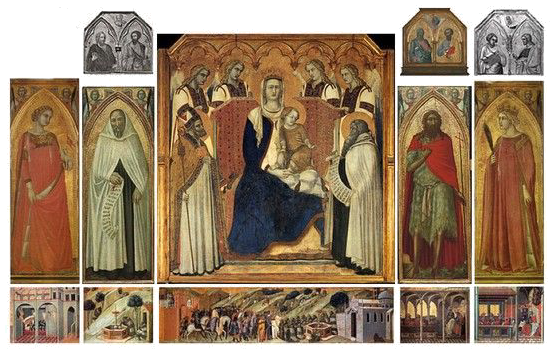
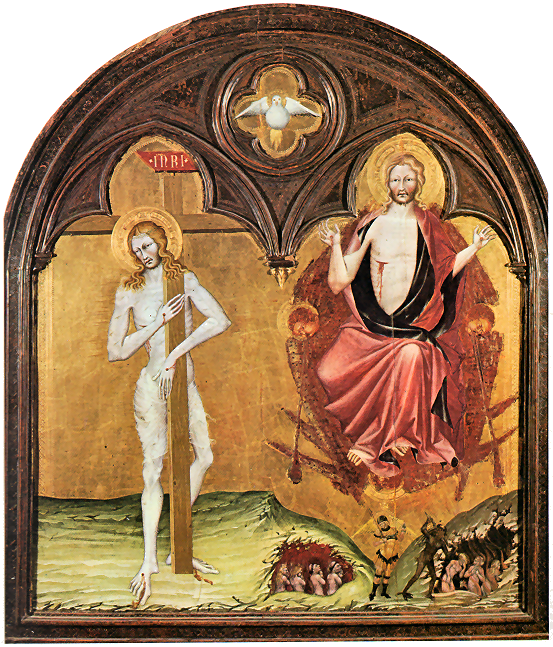
|
|
San Niccolò in Sasso
Via del Poggio |
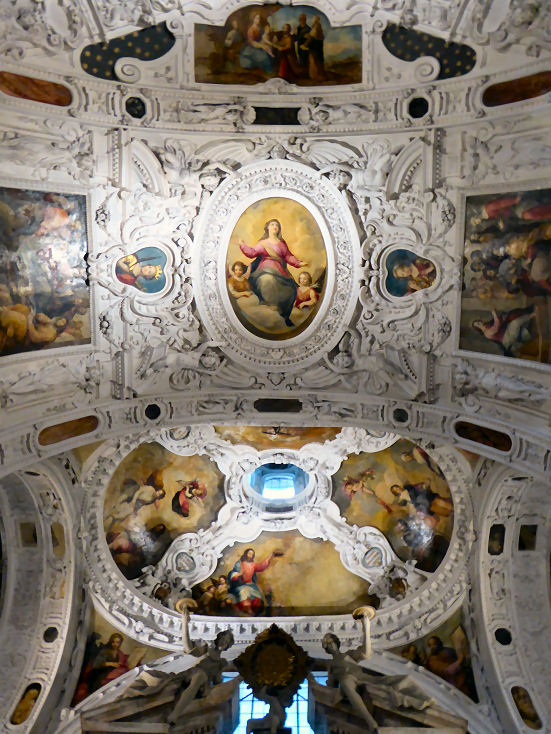 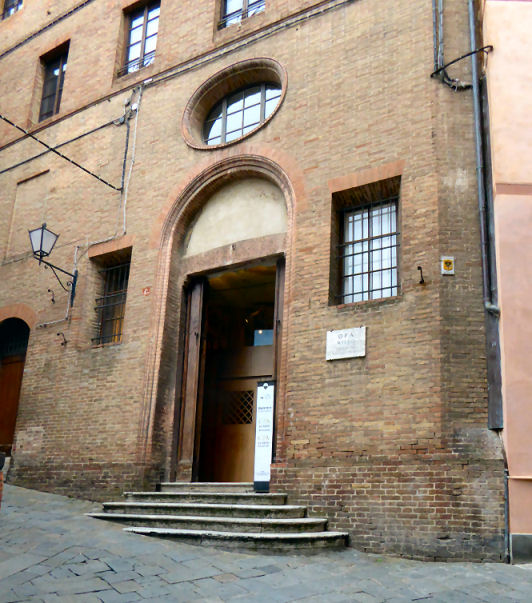
History
Originally established as part of the
convent called the Spedele di Monna Agnese, a charitable foundation
founded around 1280 by Monna Agnese, who was given property by Orlando Malavolti.
The hospital was originally for young widows and pregnant girls and was
managed by lay people. The complex was named in Sasso for being
built on pebbles.
In 1565 the building passed to the Ospedale of Santa Maria della Scala
and soon afterwards the church was completely renovated taking on its
current form. Suppressed at the end of the 18th century, hospital
functions moved to Santa Maria della Scala and the rooms here were made
into a girls' school. The deconsecrated church was put to various civil
uses until, in 1995, it became part of the Museo dell'Opera of the Duomo and is now the
museum gift shop through which you exit.
Interior
The church is now overwhelmingly late
baroque inside, with stucco decoration by Ludovico Chiappini and painted
panels by Giambattista Giustammiani from the early 17th century, mostly
depicting stories from The Life of the Virgin. Also early-17th-century are the altarpieces by Francesco Vanni (the high altarpiece
depicting The Virgin and Child Enthroned, with Saints Lawrence, Gregory,
Nicholas and Agnes), Rutilio Manetti (who contributes two), Astolfo
Petrazzi, Raffaello Vanni and Niccolò Tornioli (a Crucifixion of
1631/2).
Lost art
A 1342 altarpiece of the Presentation of the Virgin, a
fine late work by Ambrogio Lorenzetti, is in the Uffizi. A panel of the
Allegory of Redemption, also by Ambrogio, is in the Pinacoteca. It's
thought that they were originally once part of an altarpiece for an altar
dedicated to Saint Crescentius in the Duomo. They
both ended up in the Spedale di Monna Agnese
from which they were later dispersed, The Presentation going to the
Florence Accademia in 1822.
|
San Pellegrino alla Sapienza
Sant'Anastasia
Via della Sapienza |
|
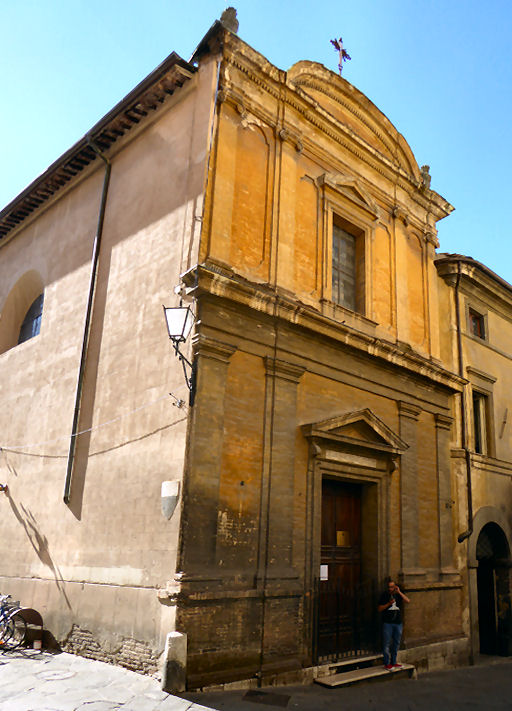 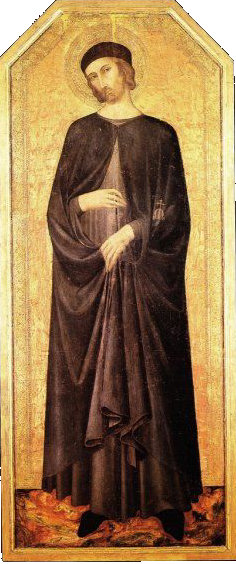
History
First documented in 1050. A
hospital called Santa Maria della Misericordia was founded here in 1240 (and enlarged
in 1321) by Beato Andrea Gallerani, the founder of the Opera della
Misericordia, a charitable foundation set up to look after orphans and the
elderly. The second niche on the right contains his portrait (see right) possibly by Lippo Memmi, who may also have been responsible for the Saint Paul
in the fifth niche on the right, and the matching Saint Peter in
the fifth niche opposite.
Council meetings were held here, and at San
Cristoforo and the Duomo, before the building of the Palazzo Pubblico.
The hospital was suppressed in 1408, part of it passing to the University
of Siena, who built the Accademia Fisiocritica in 1691 to designs by Pirro
Maria Gabbrielli. In 1758 a library founded by Sallustio Bandini opened
there.
Much rebuilding work on the church with a major reconstruction in 1767 by
Marchetti. Interior work in the 17th century.
Now called Sant'Anastasia used for Russian orthodox services.
Interior unvisited
Six statues remain of the eight of Sienese saints,
including Catherine, installed in niches
inside in 1772. The ceiling is frescoed with stories of the Life of the
Virgin. The high altar has a Birth of the Virgin by Giuseppe
Nicola Nasini.
A small marble slab depicting
The Crucifixion, sometimes
controversially given to Sienese goldsmith Guccio di Mannaia, is said to
have inspired the depiction of the Three Marys in Pietro Lorenzetti's
fresco of The Crucifixion in San Francesco.
Lost art
A very Lorenzetti-influenced Saint Michael Enthroned, with Saints Anthony Abbot and John the
Baptist (1370/75) by Angelo Puccinelli, an artist from Lucca, is in the Pinacotaca.
As are panels from
an altarpiece painted early in his career by Sassetta for the Arte della Lana
(woolworkers' guild) in 1423. It was commissioned originally to be
placed in Santa Maria del Carmine but was moved here in 1463, It was divided
up around 1777 when the Arte della Lana's chapel was destroyed. The
predella panels included the Vision of St Thomas Aquinas (Vatican
Museum), Saint Thomas in Prayer (Budapest), the Miracle of the
Sacrament (Barnard Castle UK), the Last Supper (Pinacoteca),
the Burning of a Heretic (National Gallery, Melbourne) and Saint
Anthony Beaten by Devils (Pinacoteca). Several pinnacles and pilasters
are also in the Pinacoteca. It has also been suggested that the Angel
of the Annunciation (Massa Marittima, Pinacoteca) and the Virgin
Annunciate (Yale U) belonged to this altarpiece, as well as two
landscapes, Castle by the Sea and City by the Sea (both in
the Pinacoteca), usually attributed to Ambrogio Lorenzetti.
Opening times Rarely
|
|
San Pietro
Saint Peter's -
Chiesa Anglicana
Via Giuseppe Garibaldi |
|
San Pietro a Ovile
Via del Giglio |
|

History
The building dates from 1909, but as early as 1841 a rich
widow called Lady Olivia Bernhard Sparrow, a strong evangelical and a
friend of William Wilberforce we are told, had dominated a small group of
Anglican worshippers in the city. In 1907 a church building fund was
started and in March 1908 land was bought in Via Garibaldi, with funds
provided by Mrs Georgina Allinson Hignetti, and on April 18
1909 services were held for the first time in the medieval-style church.
Opening times
Wednesdays 11-1pm, with a service at 12.30pm.
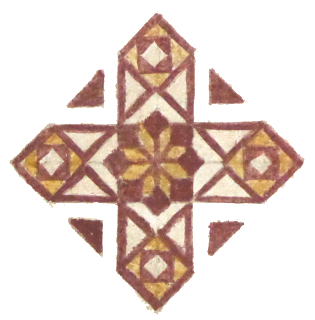 |
|
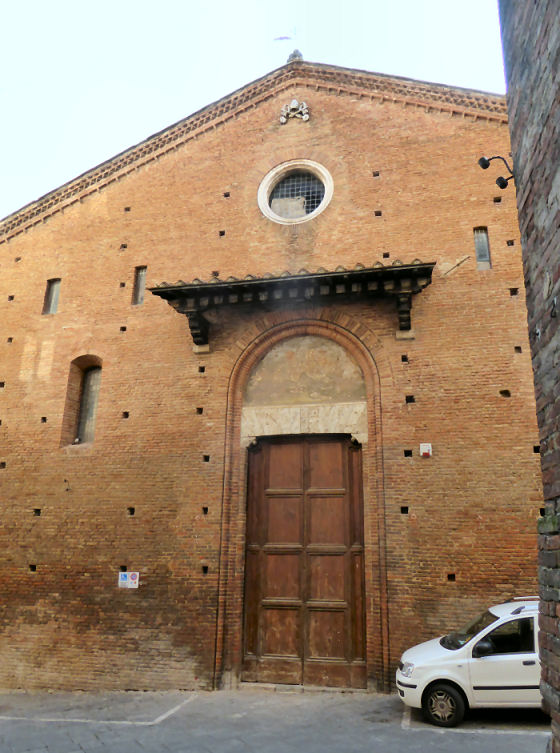
History
The original 13th century Romanesque church was probably the Franciscans' first home in the city before
the building of San Francesco nearby. Interior rebuilding in 1753. A small
fourteenth-century cloister was revealed by restoration work and is
visible from no. 28 Via del Giglio.
Still has a brick façade, the lunette over the door has
a fragmentary fresco by Rutilio Manetti
Interior unvisited
In the left aisle near the door are fresco fragments of an Annunciation and a copy
of a Maesta painted in 1350 by the anonymous Maestro di San Pietro a
Ovile. The right wall of the apse has fresco fragments probably by Bartolo di Fredi. Wooden sculptures of
the Virgin and John the Evangelist from 1415 by Domenico
dei Cori, probably made for the Duomo but troublesome circumstances
brought them here
- they
are now 'temporarily' in the Opera museum.
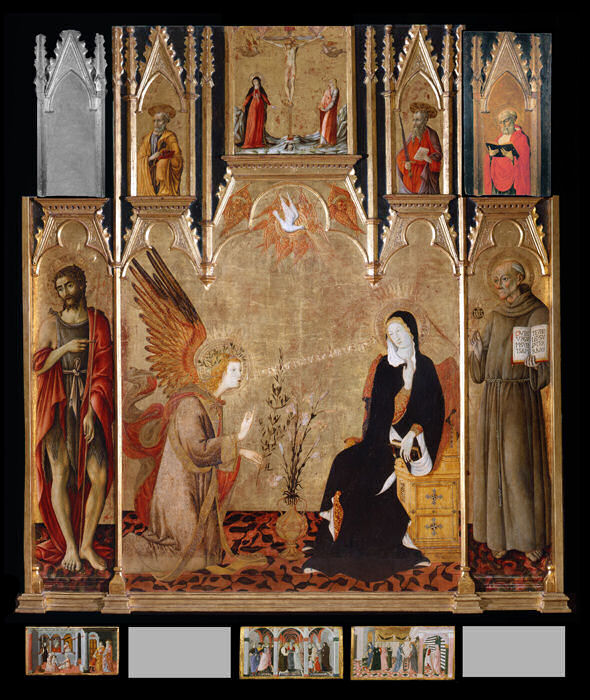
Lost art
now in the Diocesan Museum
A Virgin and Child Enthroned with Four Angels by Bartolomeo
Bulgarini from the late 14th century.
A panel showing Saint Peter by Luca di
Tommè from the 1380s.
A Virgin and Child panel of the 1390s by Andrea di Bartolo di Fredi.
A mid-15th century painted Crucifix by Giovanni di Paolo.
An Annunciation with Saints triptych (see left) commissioned from Matteo di Giovanni in the early 1450s by
this church's rector, Mariano di Nanni is now in the Diocesan Museum. Its central
section looks very like Simone Martini's famous Annunciation
(painted for the Siena Duomo but now
in the Uffizi) and is topped by pinnacles of the Crucifixion and
Saints Peter and Paul. (The top far right pinnacle is
not on display in the Diocesan Museum). The flanking main register panels
depict Saints John the Baptist and Bernardino. The
predella panels, scenes from the Life of the Virgin, are in the
Louvre and Philadelphia.
A 16th-century Sienese head of Christ Carrying the Cross.
A post-mannerist Pietà by painter and architect Santi di Tito (late
16th century).
Opening times Was quite recently used as a university
lecture hall. Currently closed.
|
San Pietro alla Magione
San Pietro in Camollia/San Pietro della Magione
Via Camollia |
|
History
Documents tell of a church here as
early as 998, built after houses and vineyards were donated by Counts
Bernardo and Gualfredo Ranieri, and their cousin Guilla. The church
belonged to the Knights Templar from the 12th century (as mentioned in a
document from 1148. With the suppression of the Templars in 1312, the
church passed to the Knights Hospitaller who later became the Knights of
Malta. With the abolition of that order the church passed to the Diocese.
Façade
Romanesque, but with a too-big 14th century gothic doorway
and a brick renaissance chapel, built 1523/6, to the right.
Interior
The Romanesque interior was restored in 1957, which resulted in the raised
presbytery and the plain semi-circular apse, which contains a
Gothic tabernacle from the second half of the 14th century. Rough stone, single nave,
with a timber roof and one niche altar either side. Detached fresco and sinopia panels.
Also a Virgin with Saints John the Baptist and Peter by Diego
Pesco, fragments of frescoes (a Cruxifixion and Old Testament
Stories) by Cristoforo Bindoccio and Meo di Pero.
The chapel on the
right was erected in 1523-26 as an ex voto for the end of the
plague. It houses a Martyrdom of St Donnino and Saint Hugh
by Antonio Nasini/questionable? and a fragment of a Virgin with Child
attributed to Lorenzo Rustici/Bartolomeo Neroni called Riccio?
Opening times
9.00 - 6.30 Autumn/Winter
9.00 - 8.00 Spring/Summer
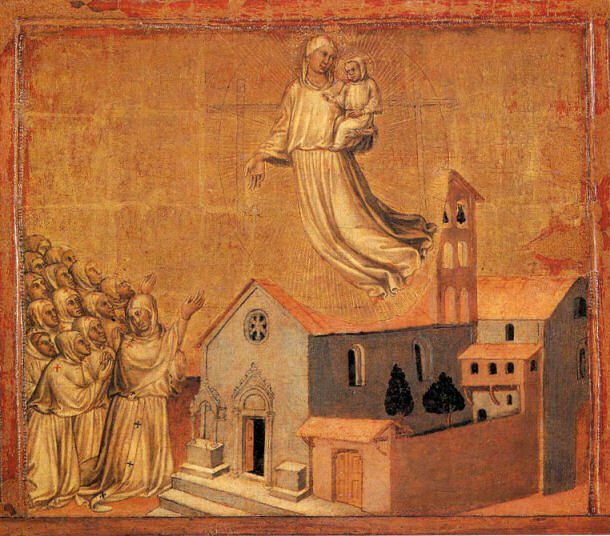
A predella panel by Martino di Bartolomeo showing the
Apparition of the Virgin Over the Church of the Magione.
Now in the museum of the Banca Monte dei Paschi. |
|
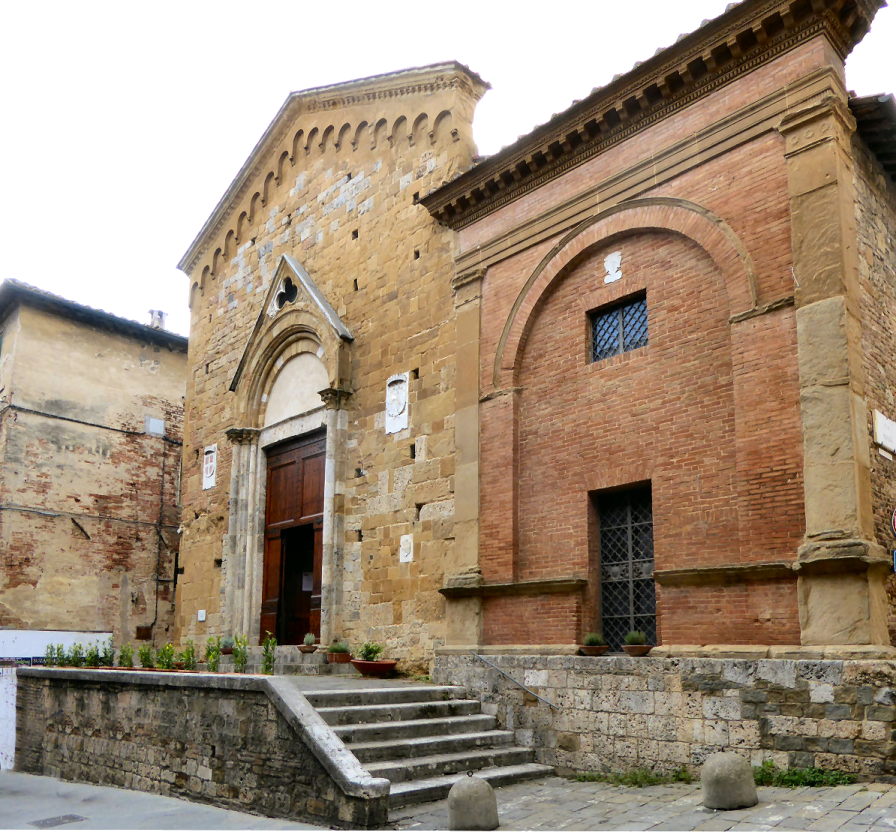
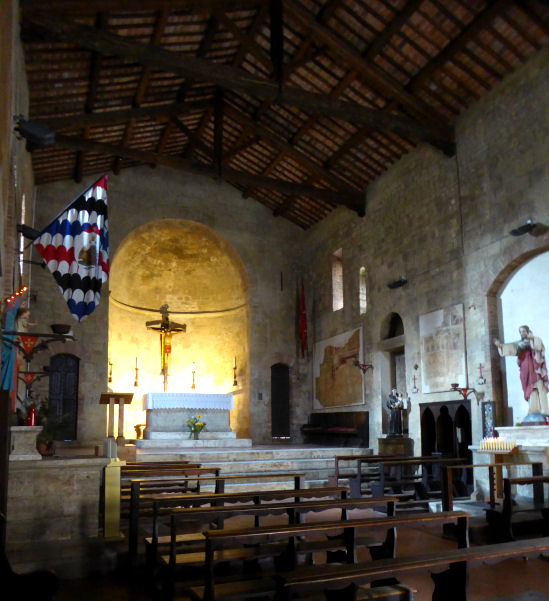 |
|
San Pietro in Castelvecchio
San Pietro alle Scale
Via San Pietro |
|
History
A parish church built in
13th century, but rebuilt baroque in the 18th century.
Interior
Wide, plain, no aisles, and not much art, with one altar each side of
the nave. The right-hand one has an unlabelled painting with a light to
turn on, which just shows its texture. There is modern stained glass at
clerestory level on the right, over the entrance, and on the walls of the
choir. The choir and transept are the same width and merge into one
hall-type space, with an octagonal dome over the altar.
A standard painted for the lay Compagnia di San Rocco by Rutilio Manetti,
with Saints Roch and Job Intercessing for Siena on one side and Saints
Catherine of Siena and Roch on the other is in a glass case in the left
transept.
The high altarpiece is The Rest on the Flight into Egypt by Rutilio
Manetti of 1621 (from the church of Santa Maria in Portico ai Fontegiusta.)
Art highlight
The five panels from a dismantled polyptych attributed to Ambrogio
Lorenzetti (c.1340) (see below) have now been returned to the back wall
to the left of the high altar, in the framing
made for the 2018 exhibition, but now unlabeled.
The five panels from the dismantled polyptych were
restored for the major Ambrogio Lorenzetti exhibition in Siena in 2017/18
where the photo below was taken.
The centre panel seems to have oddly depicted the Virgin standing, and
holding a very wild looking Child. The side panels show Saints Cecilia,
Peter, Paul and the archangel Michael. The centre
pinnacle, Christ Blessing, used to be in the Museo Diocesano. The four
side pinnacles and all the framing are lost. The polyptych had been in the
church since at least the early sixteenth century, but by 1785 had been
removed from the high altar and broken up and remained little known until
well into the 20th century. It's attribution has been doubted, having
swung from a follower of Lorenzetti to 'Lorenzo Lorenzetti' – an invented
painter-father of Pietro and Ambrogio. The recent restoration has swung
opinion back to the attribution to Ambrogio himself.
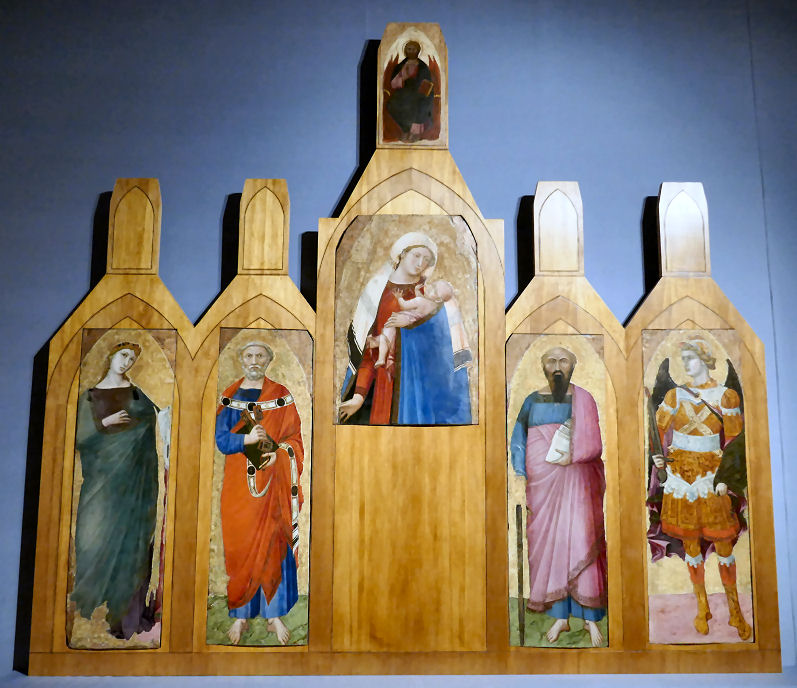
Lost art
A panel depicting Saint Bartholomew from a polyptych finished in 1451,
begun by Sassetta and finished by his colleague Sano di Pietro upon
Sassetta's death, is in the Pinacoteca. As is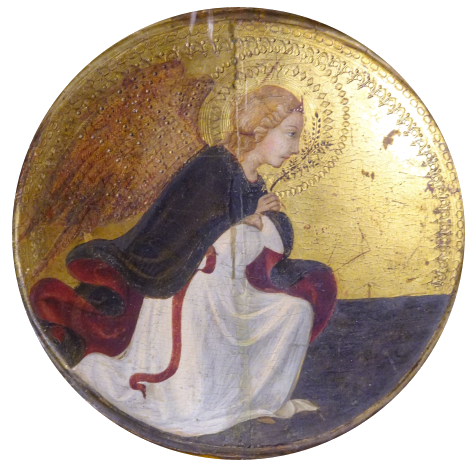 Sano di Pietro’s solo Saint
Francis from the same altarpiece, which was commissioned by Bartolomeo di Francesco
Guglielmo for his chapel dedicated to Christ’s Nativity here.
Sassetta's panel of the Blessing Redeemer, previously given to
Nicola di Ulisse, from the same altarpiece, is in the Diocesan Museum,
still labelled as by Nicola.
Sano di Pietro’s solo Saint
Francis from the same altarpiece, which was commissioned by Bartolomeo di Francesco
Guglielmo for his chapel dedicated to Christ’s Nativity here.
Sassetta's panel of the Blessing Redeemer, previously given to
Nicola di Ulisse, from the same altarpiece, is in the Diocesan Museum,
still labelled as by Nicola.
Individual panels of the Virgin and Child, an
Annunciate Angel (see right) and Saint Lucy by Sano di Pietro
are in a glass case in the Diocesan Museum.
Opening times
7.30-1.30
|
|
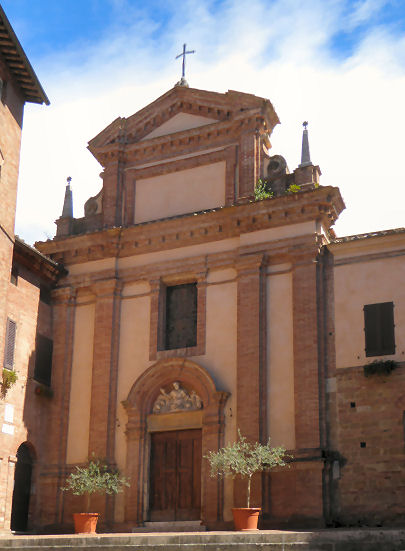
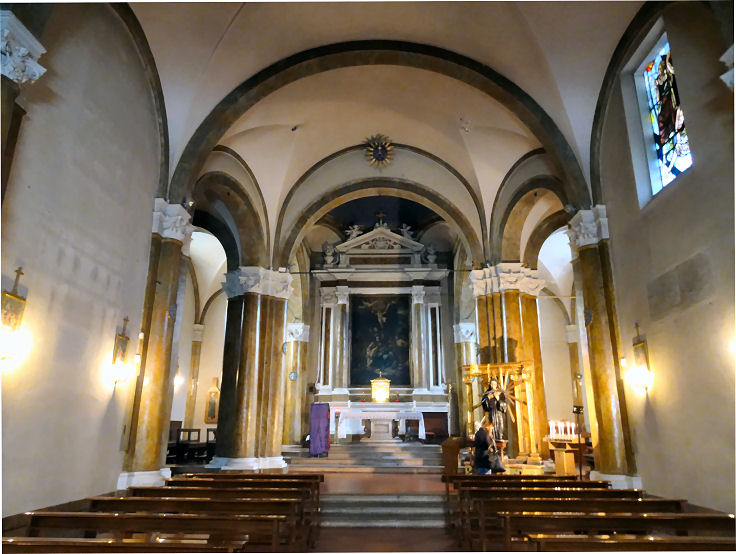
|
|
San Raimondo al Refugio
Via del Refugio |
|
History
The Refugio, established in
Siena in the 1580s, were dedicated to helping poor abandoned girls. It was
founded by Domenico Billò but following his death in 1593 it came under
the protection of the Chigi. Aurelio Chigi aquired additional property in
1601 and construction of the the church began, by Sienese architect Benedetto Giovannelli Orlandi.
The Chigi arms are still huge and
high on the façade. The dedication to the Dominican Saint Raymond of
Peńafort coincided with his canonisation the year work began. The architect was asked to create the façade and the
short road leading up to it. The vault was damaged in the earthquake of 1798.
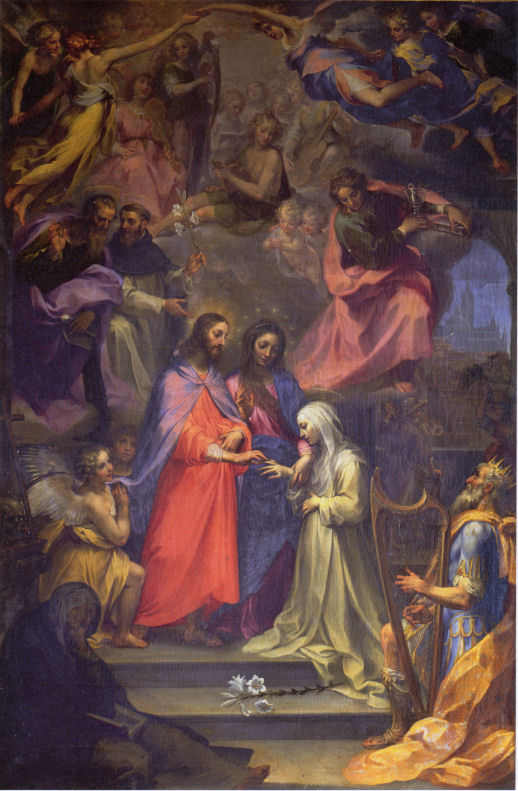 Interior Interior
Baroque, congested and aisleless, with
much white and gilded plasterwork, of course. The
nave is square with a painted dome ceiling. There are three large
altarpieces, over the main and each of the side altars,
and eight small panels. All 17th-century and sweet bordering on insipid.
The Nativity by Alessandro Casolani was left unfinished at his
death in 1607 and completed by Francesco Vanni. Ventura Salimbeni's
Death of San Galgano from c.1607 was probably finished by Vanni, his
half-brother. Vanni also painted another local saint, in
the garish c.1601 Mystic Marriage of Saint Catherine of Siena in this
church (see left). In accordance with the account given by her
biographer, Raymond of Capua, the episode is attended by Saints John the
Evangelist, Paul and Dominic and the kneeling King David. The tomb of Aurelio Chigi is very
noticeable in the centre of the aisle. The
entrance hallway
under under the organ retains its screen.
The old sacristy is off the left
here and has a large case
of reliquaries and the like and two nice 15th century gold ground Virgins
by Sano di Pietro (con Bambino) and Domenico di Bartolo (Assunta, head and
shoulders) and a Jacopo della Quercia full size carved & painted wooden
Saint Catherine of Alexandra.
Nicely kept, and staffed by volunteers, I found, from the Fondazione Conservatori Riuniti di Siena.
Opening times
Wednesday and Saturday 9.30-1.00
|
|
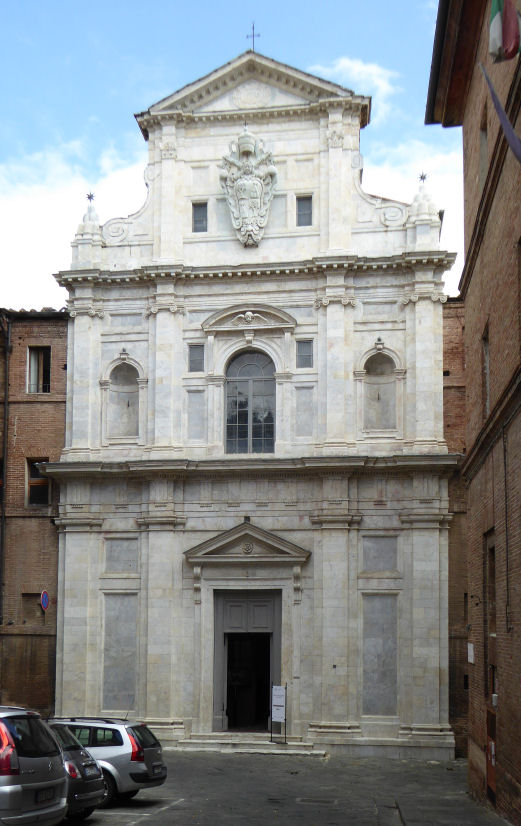
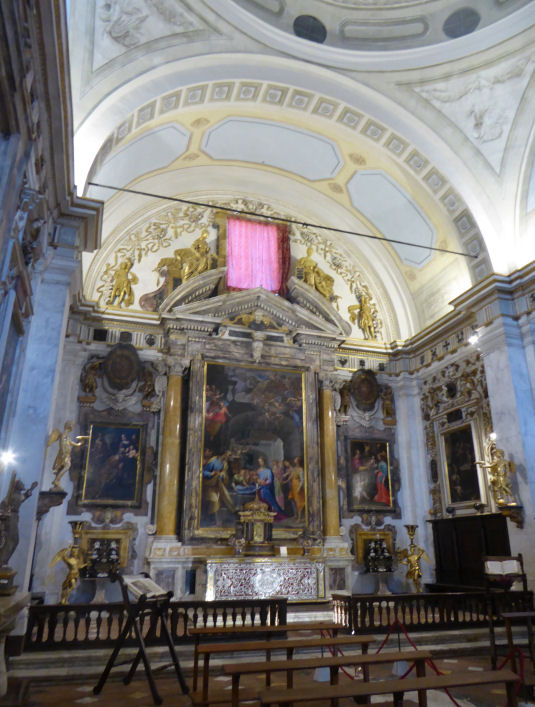
|
|
San Rocco
Oratory -
Via Vallerozzi |
|
San Salvadore
Oratory -
Via Duprè |
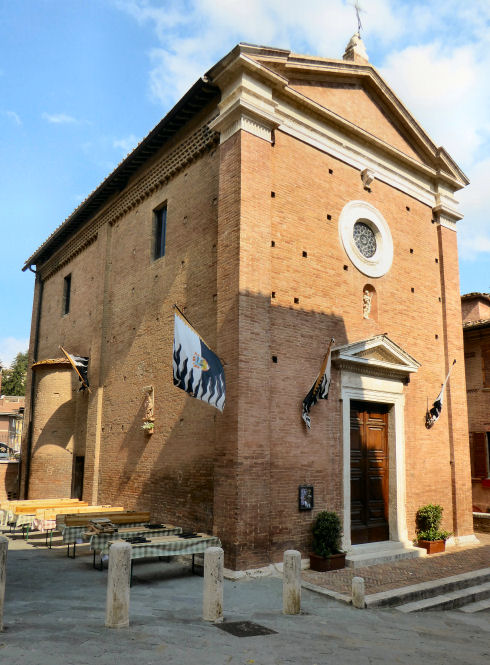
History
Built from May 1511, by local subscription.
Contains 17th-century works
by Rutilio Manetti (frescoes of the Life of San Rocco from 1605-10), Raffaello Vanni and others.
The home of the Lupa (she-wolf) contrada
since 1789. The district's museum here has an altarpiece of The
Apparition of the Virgin before San Rocco signed in 1603 by Ventura
Salimbeni.
Opening times
Rarely |
|
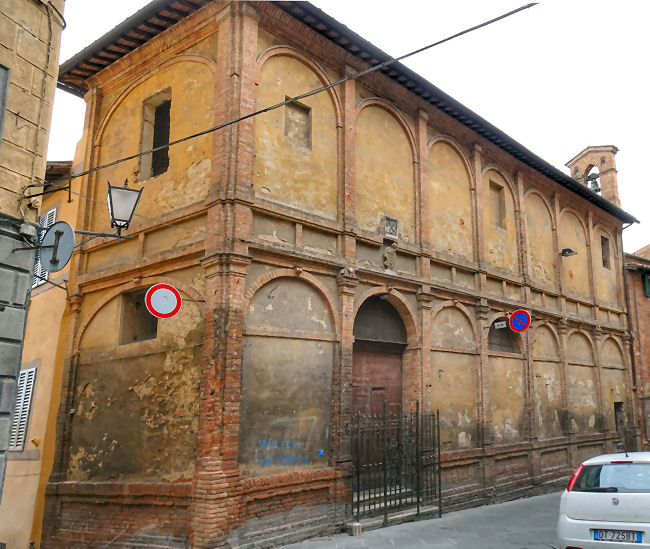
History
A church is first mentioned here in a document dated 1230. The Umiliati
were here first, then the Servites. An oratory was built in 1589,
dedicated to the Visitazione di Maria Santissima and used by the Contrada
dell'Onda, with its headquarters on the upper floor. In 1729 the oratory
was restored and became the church of San Salvadore. From 1602 to 1787 the
oratory was the seat of the Contrada dell'Onda, when San Salvadore was
suppressed and the Contrada obtained the Oratory of San Giuseppe from the
Grand Duke Pietro Leopoldo. The contrada's valued painting of the
Virgin and Child moved at this time to
San Giuseppe.
|
|
San Sebastiano
Oratory -
Piazzeta della Selva |
|
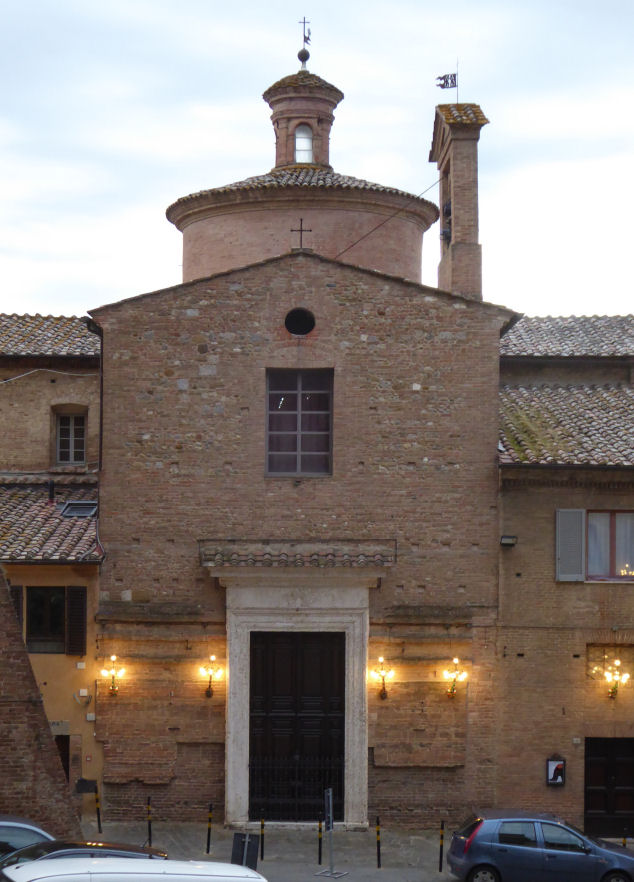
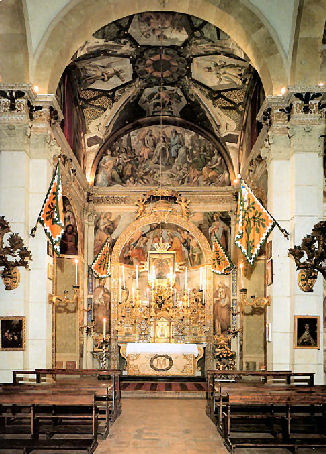
History
Built by the Weavers' Guild from 1493,
Saint Sebastian being their patron saints, under the direction of Girolamo
Ponsi, probably to designs by Francesco di Giorgio Martini. The oratory
was functioning by 1514, but not nearly finished until around 1550 with rebuilding in
the 1650s. Following the Leopoldine suppressions of the late 18th century
the oratory passed from the Weavers' Guild to the Pantera contrada, who
were here from 1786 to 1810 In 1818 the French government granted it to the Selva (Forest) contrada,
who remain. The 15th-century crypt houses their museum.
Interior unvisited
A Greek cross topped by a dome.
There are late-16th early-17th century frescoes inside by Pietro Sorri,
Giovanni Paolo Pisani and Raffaello Vanni. The paintings by 17th century Sienese artists mostly
depict the life of the saint, Rutilio Manetti being the most
accomplished. Over the altar is the Madonna of the Forest in stucco
and polychrome terracotta from c.1474. It is attributed to Francesco di
Giorgio Martini who is also said to have designed the church.
Opening times
Rarely
|
San Vigilio
Via San Vigilio |
|
 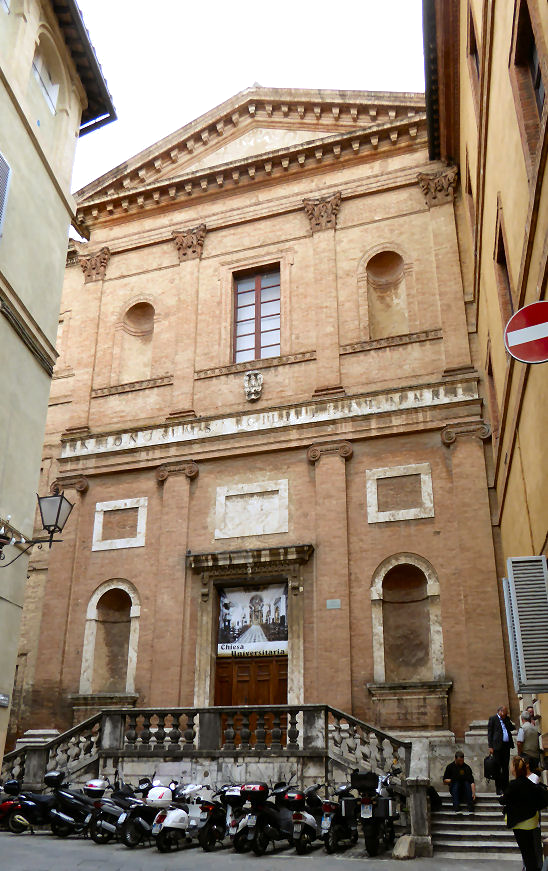
History
Originally a parish church built by the
Ugurgieri family, the church passed to the the Camaldolese order in
the 11th century with their convent next door. The church burned down in a
fire in 115, and was rebuilt by 1231. In 1420 the monks were expelled and
in 1556 passed to the Jesuits, who rebuilt the church from 1561 and
continued to refurbish until 1775. When the Jesuits were suppressed in
1759, the church was acquired by the Vallombrosan order, who had the
facade rebuilt in its present form by architect Antonio Matteucci. When
the Vallombrosans were suppressed in 1816 the Grand Duke of Tuscany gave
the church to the University of Siena, who are still here.
Interior
Aisleless with three deep chapels each side. Plain walls but the chapels
and semi-circular apse are very decorated. The ceiling is decorated with fifteen canvases
in various shapes and sizes by Raffaello Vanni depicting
The Last Judgement. The chapel of St Francis Xavier has works by
Francesco Vanni and Baldassare Franceschini. The chapel of the Madonna di
Loreto is decorated with canvases by Francesco Vanni of The
Assumption of the Virgin and The Translation of the Holy House.
The high altarpiece depicting the Glory of Saint Ignatius is by Mattia
Preti. Flanking it are two canvases by Francesco Vanni depicting Jesuits -
Aloysius (Luigi) Gonzaga and The Blessed Stanislaus Kostka
Receiving Communion from Angels with Saint Barbara, of c.1605-6.
Opening times
Sunday evening services
click here for Page 2

home
Centre
::
East ::
West ::
Oltrarno ::
Fiesole
Siena
† Pisa
|
|
|
|
|




 an allied bombardment in 1944. The destruction revealed a parchment strip
signed by the artist in 1338 asking us to worship the son of God, not the
wood, and the reliquary of Saint Bernardino of Siena (mid- 15th
century).
an allied bombardment in 1944. The destruction revealed a parchment strip
signed by the artist in 1338 asking us to worship the son of God, not the
wood, and the reliquary of Saint Bernardino of Siena (mid- 15th
century).

 Interior unvisited
Interior unvisited It
features a detailed battle scene around Siena in its bottom quarter.
It
features a detailed battle scene around Siena in its bottom quarter.
 The left wall altar has a panel of The Ascension by Girolamo del
Pacchia
with a three panel predella depicting the Annunciation to Joseph, the
Flight
into Egypt and the Adoration of the Magi.
The left wall altar has a panel of The Ascension by Girolamo del
Pacchia
with a three panel predella depicting the Annunciation to Joseph, the
Flight
into Egypt and the Adoration of the Magi.



